9.1: What Is a Product?
9.1.1: Defining Product
A product is any good, service, or idea that can be offered to a market to satisfy a want or need.
Learning Objective
Break down the different components that make up tangible and intangible products
Key Points
- Products can be goods, services, or ideas, such as intellectual property.
- Products can be tangible or intangible.
- Products can also be classified by use, by brand, or by other classifications as well.
Key Term
- product
-
Any tangible or intangible good or service that is a result of a process and that is intended for delivery to a customer or end user.
Example
- A soccer ball is an example of a tangible product. An example of an intangible product is insurance.
What Is a Product?
In general, a product is defined as a “thing produced by labor or effort” or the “result of an act or a process. ” The word “product” stems from the verb “produce”, from the Latin prōdūce(re) “(to) lead or bring forth. ” Since 1575, the word “product” has referred to anything produced.
In marketing, a product is anything that can be offered to a market that might satisfy a want or need. In retail, products are called merchandise. In manufacturing, products are purchased as raw materials and sold as finished goods. Commodities are usually raw materials such as metals and agricultural products, but the term can also refer to anything widely available in the open market. In project management, products are the formal definition of the project deliverables that form the objectives of the project.
Goods, Services, or Ideas
Goods are a physical product capable of being delivered to a purchaser and involve the transfer of ownership from seller to customer.
A service is a non-material action resulting in a measurable change of state for the purchaser caused by the provider.
Ideas (intellectual property) are any creation of the intellect that has commercial value, but is sold or traded only as an idea, and not as a resulting service or good. This includes copyrighted property such as literary or artistic works, and ideational property, such as patents, appellations of origin, business methods, and industrial processes.
Product Classification: Tangible or Intangible
A product can be classified as tangible or intangible.
A tangible product is a physical object that can be perceived by touch such as a building, vehicle, or gadget. Most goods are tangible products. For example, a soccer ball is a tangible product .

Soccer Ball
A soccer ball is an example of a tangible product, specifically a tangible good.
An intangible product is a product that can only be perceived indirectly such as an insurance policy. Intangible data products can further be classified into virtual digital goods (“VDG”), which are virtually located on a computer OS and accessible to users as conventional file types, such as JPG and MP3 files. Virtual digital goods require further application processing or transformational work by programmers, so their use may be subject to license and or rights of digital transfer. On the other hand, real digital goods (“RDG”) may exist within the presentational elements of a data program independent of a conventional file type. Real digital goods are commonly viewed as 3-D objects or presentational items subject to user control or virtual transfer within the same visual media program platform. Services or ideas are intangible.
Product Classification: By Use or By Association
In its online product catalog, retailer Sears, Roebuck and Company divides its products into “departments”, then presents products to potential shoppers according to function or brand. Each product has a Sears item-number and a manufacturer’s model-number. Sears uses the departments and product groupings with the intention of helping customers browse products by function or brand within a traditional department-store structure.
A product line is “a group of products that are closely related, either because they function in a similar manner, are sold to the same customer groups, are marketed through the same types of outlets, or fall within given price ranges. ” Many businesses offer a range of product lines which may be unique to a single organization or may be common across the company’s industry. In 2002 the US Census compiled revenue figures for the finance and insurance industry by various product lines such as “accident, health and medical insurance premiums” and “income from secured consumer loans. ” Within the insurance industry, product lines are indicated by the type of risk coverage, such as auto insurance, commercial insurance, and life insurance.
9.1.2: Benefits and Solutions
The core benefit is what consumers feel they are getting when they purchase a product.
Learning Objective
Review the four levels of product differentiation
Key Points
- The same product may have different core benefits to different users. For example, one user may install a pool for fitness purposes, while another may do so for status.
- Different target markets will have different core products, and it is up to the marketer to discover which markets must be targeted for their particular product.
- Further layers of product benefits are the tangible product, the augmented product, and the promised product. These also affect the buyer’s decision making, and cannot be ignored by the marketer.
Key Terms
- core product
-
The core product identifies what the consumers feel they are getting then they purchase the product.
- tangible product
-
The tangible product is reflected in the quality, features, brand name, styling, and packaging.
- augmented product
-
The supporting services surrounding the product, such as after-sales service for a machine, or parking spaces for a department store.
Example
- A specialized department store selling high-end luxury goods will attract buyers looking to augment their status through the purchase of luxury goods. Goods will need to be displayed to show the tangible benefits, such as their quality and features. The department store will also need ample parking, bathrooms, changing rooms, escalators, elevators, helpful staff, and other augmented benefits. Finally, while the products in the store have a promised benefit – that of status, and of winning the admiration of peers – there is no guarantee that this will hold true.
Benefits & Solutions
The four levels of a product include: core, tangible, augmented, and promised . Core, tangible, augmented and promised products feature characteristics (i.e., the total product concept or offer), which includes everything a consumer evaluates before making a purchase. These factors can include:
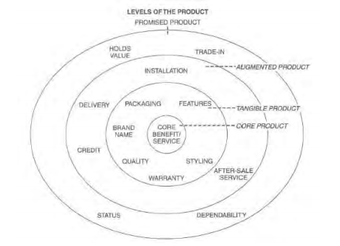
Levels of the Product
The four levels of a product include core, tangible, augmented, and promised.
- Price
- Store environment and/or surroundings
- Brand promise/value
- Advertising and marketing activities
- Buyer’s past experience
- Accessibility or convenience
- Brand reputation
- Packaging
We begin with the notion of the core product, which identifies what the consumers feel they are getting when they purchase the product. The core benefits derived when an overweight 45-year-old male purchases a $250 ten-speed bicycle is not transportation–it is the hope for better health and conditioning. In a similar vein, that same individual may install a $16,000 swimming pool in his backyard, not to obtain exercise, but to reflect the status he so desperately desires. Both are legitimate product cores. Because the core product is so individualized, and oftentimes vague, a full-time task of the marketer is to accurately identify the core product for a particular target market.
Once the core product has been indicated, the tangible product becomes important. This tangibility is reflected primarily in its quality level, features, brand name, styling, and packaging. Literally every product contains these components to a greater or lesser degree. Unless the product is one-of-a-kind (e.g. oil painting), the consumer will use at least some of these tangible characteristics to evaluate alternatives and make choices. In addition, the importance of each will vary across products, situations, and individuals. For example, for a 25-year old man, the selection of a particular brand of new automobile (core product = transportation) was based on tangible elements such as styling and brand name (choice = Corvette). In contrast, at age 45, the core product remains the same, but tangible components such as quality level and features become more important (choice = Mercedes).
The next level is the augmented product. Every product is backed up by a host of supporting services. The buyer often expects such services, so they will reject the core-tangible product if these are not available. Examples include restrooms, escalators, and elevators in the case of a department store, and warranties and return policies in the case of a lawn mower. For example, Dow Chemical has earned a reputation as a company that will go the distance to service an account. It means that a Dow sales representative will visit a troubled farmer after-hours in order to solve a serious problem. This extra service is an integral part of the augmented product and a key to their success. In a world with many strong competitors and few unique products, the role of the augmented product is clearly increasing.
The outer ring of the product is referred to as the promised product. Every product has an implied promise. An implied promise is a characteristic that is attached to the product over time. The car industry rates brands by their trade-in value. There is no definite promise that a Mercedes-Benz holds its value better than a BMW. There will always be exceptions. How many parents have installed a swimming pool based on the implied promise that their two teenagers will stay home more or that they will entertain friends more often?
9.1.3: Features and Attributes of a Product
The features and attributes of a product are integral to the product design process, which in turn assists in the creation of new products.
Learning Objective
Discuss how features and attributes factor into the product design process
Key Points
- The design process of products focuses on figuring out what features are required, brainstorming possible ideas, creating mock prototypes, and then generating the product.
- The features and attributes of a product play a role in all three sections of the design process: Analysis,Concept, and Synthesis, which form a continuous feedback loop.
- Feature creep is the ongoing expansion and addition of new features in a product, often to the detriment of the product design process.
Key Terms
- attribute
-
a characteristic or quality of a thing
- analysis
-
In product design, the analysis stage is where designers begin research on how to find a solution to the problem at hand.
- feature creep
-
The tendency of a design project or product cycle to accumulate more and more features or details, rather than to be completed and released at a more basic level.
Example
- The Swiss army knife is an example of a product that has evolved over time as new features and attributes have been added.
Product Design
This is the process of creating a new product to be sold by a business to its customers. It is the efficient and effective generation and development of ideas through a process that leads to new products.
The process of designing a new product (or updating the features of an existing one) is usually completed by a group of people, designers or field experts in the product they are creating, or specialists for a specific component of the product. These people would essentially determine all the features and attributes of the product. The process entails focuses on figuring out what is required, brainstorming possible ideas, creating mock prototypes, and then generating the product. At this point, product designers would still need to execute the idea, making it into an actual product and then evaluating its success and seeing if any improvements are necessary.
Product designers conceptualize and evaluate ideas, turning them into tangible products. Their role is to combine art, science, and technology to create features and attributes of current or new products that other people can use. Their evolving role has been facilitated by digital tools that now give them greater freedom to communicate, visualize, and analyze ideas.
The Design Process
This follows a guideline and involves three main sections: Analysis, Concept, and Synthesis – in a continuous feedback loop. Attributes and features play a role in all three sections.
Analysis: Here, the designers decide on committing to the project and finding a solution to the problem. They pool their resources into deciding how to solve the task most efficiently. Everyone in the team begins research into what the product should look like to satisfy the objective.
Concept: The key issue of the matter is defined. The conditions of the problem become objectives, and restraints on the situation become the parameters within which the new design must be constructed. The concept phase is where ideas for new features are considered.
Synthesis: The designers brainstorm different solutions for their design problem. Once they have narrowed down their ideas to a select few, they can outline their plan to make the product. Prototypes are built, the plan outlined in the previous step is realized and the product starts to become an actual object.
In the evaluation stage, the product is tested, and from there, improvements are made. Although this is the last stage, it does not mean that the process is over. The finished prototype may not work as well as hoped so new ideas may need to be brainstormed.
It is through this process of analysis, concept and synthesis that products are designed, with specific features and attributes added in order to maximize the use value and desirability of the product to the final user.
Example
Different types of products will have varying levels of sophistication when it comes to features. For example, the Swiss army knife. Various models exist, with different tool combinations for specific tasks designed for everyday use. The simplest model sold includes only a single blade, the most complicated model features many extra tools like: a smaller second blade, tweezers, toothpick, corkscrew, can opener, bottle opener, slotted/flat-head screwdriver(s), phillips-head screwdriver, nail file, scissors, saw (regular, wood), file, hook, magnifying glass, ballpoint pen, fish scaler, and so on.
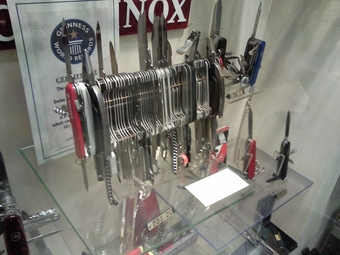
“The Giant” Swiss Army Knifer
Since 2006, Wenger has produced a knife called “The Giant.” It includes every implement the company has ever made. With 87 tools and 141 different functions. Although expansive, it is not as portable as other knives.
Feature Creep
The evolution of the Swiss army knife may be seen as a good example of this phenomenon: the ongoing expansion and addition of new features to a product. Extra features go beyond the basic function of the product and so can result in over-complication rather than maintaining a simple design. Viewed over a longer time period, extra or unnecessary features seem to creep into the system, beyond the initial goals.
The most common cause of feature creep is the desire to provide the consumer with a more useful or desirable product, in order to increase sales or distribution. However, once the product reaches the point at which it does everything that it is designed to do, the manufacturer is left with the choice of adding unneeded features, sometimes at the cost of efficiency, or sticking with the old version, at the cost of a perceived lack of improvement. While feature creep may have positive effects, it can also lead to cost overruns and product cancellations as producers lose sight of the original goal.
9.2: Types of Products
9.2.1: Consumer Products
A consumer product is any tangible product for sale that is used by a person or household for non-business purposes.
Learning Objective
Describe the characteristics of consumer products
Key Points
- Consumer products are defined on a case-by-case basis, under guidelines defined by the US CPSA.
- The production and sale of consumer products is an important component of US GDP and employment.
- The Consumer Product Safety Act, enacted in 1972, established the United States Consumer Product Safety Commission (CPSC) as an independent agency of the United States Federal Government and defined its basic authority.
Key Terms
- consumer product
-
Any tangible product used for personal, family, and household non-business purposes.
- durability
-
Permanence by virtue of the power to resist stress or force.
- Consumer Product Safety Act
-
Act enacted by US Congress in 1972, establishing the Consumer Product Safety Commission as an independent agency of the US Federal Government.
Example
- Examples of consumer products are music players, TVs, smart phones, designer clothing, children’s toys, and handbags.
A consumer product is generally any tangible product for sale that is used for personal, family, household or non-business purposes. To determine whether an item is a consumer product requires a factual finding, on a case-by-case basis. This will vary from one jurisdiction to another.
As an example, The United States Consumer Product Safety Act (CPSA), enacted in 1972 by Congress, has an extensive definition of consumer product: “any article, or component part thereof, produced or distributed (i) for sale to a consumer for use in or around a permanent or temporary household or residence, a school, in recreation, or otherwise, or (ii) for the personal use, consumption or enjoyment of a consumer in or around a permanent or temporary household or residence, a school, in recreation, or otherwise; but such term does not include— (A) any article which is not customarily produced or distributed for sale to, or use or consumption by, or enjoyment of, a consumer”. It then goes on to list eight additional specific exclusions and some further miscellaneous details.
The act also established the United States Consumer Product Safety Commission (CPSC) as an independent agency of the US Federal Government and defined its basic authority. The act gives the CPSC the power to develop safety standards and pursue recalls for products that present unreasonable or substantial risks of injury or death to consumers. It also allows the CPSC to ban a product if there is no feasible alternative.
The CPSC has jurisdiction over more than 15,000 different products; however, the CPSA excludes from the CPSC’s jurisdiction those products that expressly lie in another federal agency’s jurisdiction, for example food, drugs, cosmetics, medical devices, tobacco products, firearms and ammunition, motor vehicles, pesticides, aircraft, and boats. These products may fall under the purview of agencies such as the US Food and Drug Administration, the US Bureau of Alcohol, Tobacco, Firearms and Explosives, the US Department of Agriculture, the US Department of Transportation, the US Environment Protection Agency, the US Federal Aviation Administration, and the US Coast Guard.
Another type of consumer products can be classified as products you don’t need, like candy, luxury goods, and toys . Following WWI, America went into a recession after manufacturing many war products and having to pay off all of its debts to factories and the common people. Under the Coolidge presidency, America started manufacturing consumer products to create more jobs and get people to start spending so the government could raise money.
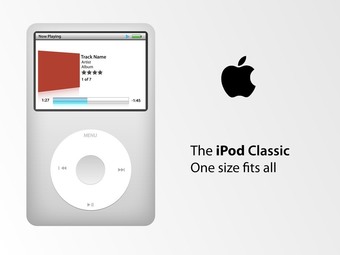
iPod Classic
The iPod Classic is an example of a consumer product.
Thus, while consumer products may be seen as those not essential to life, they are nonetheless a large and crucial component of the US economy. The production and sale of consumer goods is an important sector of US GDP and creating employment.
Consumer products will generally be less expensive than professional-grade goods, but will lack the durability of the latter product class, and will reach obsolescence quicker.
9.2.2: Shopping Products
Convenience goods are those that require little effort on the part of the buyer, while shopping goods require research and comparison.
Learning Objective
Discuss the characteristics of shopping products as a specific type of product
Key Points
- Since little planning or effort goes into buying convenience goods, markets need to establish a high level of brand awareness and recognition.
- Since shopping goods are highly researched, and product information is evaluated by buyers, a retailer’s ability to differentiate themselves becomes important.
- With shopping goods, retailers attempt to provide strong promotions to sway the buyer. They also expect strong support from manufacturers.
Key Terms
- convenience good
-
a good that requires a minimum amount of effort on the part of the consumer.
- shopping good
-
goods that consumers will want to be able to compare and contrast with others before they make a purchasing decision.
Example
- Cars, houses and laptops are all examples of shopping goods.
Classification of Consumer Goods: Convenience, Shopping and Specialty goods
A classification long used in marketing separates products targeted at consumers into three groups: convenience, shopping, and specialty. In this section, we will differentiate between convenience and shopping goods. Specialty goods will be discussed in the next section.
A convenience good is one that requires a minimum amount of effort on the part of the consumer. Extensive distribution is the primary marketing strategy. The product must be available in every conceivable outlet and must be easily accessible in these outlets. Vending machines typically dispense convenience goods. These products are usually of low unit value, are highly standardized, and are frequently nationally advertised. Yet, the key is to convince resellers, i.e. wholesalers and retailers, to carry the product. If the product is not available when, where, and in a form desirable by the consumer, the convenience product will fail.
From the consumer’s perspective, little time, planning, or effort go into buying convenience goods. Consequently, marketers must establish a high level of brand awareness and recognition. This is accomplished through extensive mass advertising, sales promotion devices such as coupons and point-of-purchase displays, and effective packaging. The fact that many of our product purchases are often on impulse is evidence that these strategies work.
Availability is also important. Consumers expect a wide spectrum of products to be conveniently located at their local supermarkets, ranging from packaged goods used daily, such as bread and soft drinks, to products purchased rarely or in an emergency such as snow shovels, carpet cleaners, and flowers.
In contrast, shopping goods are items that consumers want to be able to compare and contrast with others before they make a purchasing decision. Automobiles, appliances, furniture, and homes are in this group. Shoppers are willing to go to some lengths to compare quality by setting an criteria to judge the product’s specifications, usage, price, and value. Shopping goods do not necessarily have to be distributed widely. Although many shopping goods are nationally advertised, often it is the ability of the retailer to differentiate itself that creates the sale. The differentiation could be equated with a strong brand name, such as Sears Roebuck or Marshall Field, effective merchandising, aggressive personal selling, or the availability of credit.
Discounting, or promotional price-cutting, is a characteristic of many shopping goods because of retailers’ desire to provide attractive shopping values. In the end, product turnover is slower, and retailers have a great deal of their capital tied-up in inventory. This, combined with the necessity to price discount and provide exceptional service means that retailers expect strong support from manufacturers with shopping goods.

Buying a Car
Most buyers invest a lot of time and effort into choosing the right car for them.
An example of a shopping good is a car. Many buyers conduct extensive research into buying a car. Examples of questions that the buyer will ask themselves include: do I want to buy a new or a used car? What is my maximum budget? Do I want an SUV or not? What brand has the best safety features? Which car is fastest? Which has the most storage space? Which has the best service? Which car looks best? There is an entire industry built around helping buyers decide what car is best for them.
9.2.3: Specialty Products
Specialty goods are those considered unique by the buyer, who will go to great lengths to get them.
Learning Objective
Illustrate the characteristics and consumer motivation connected to specialty products
Key Points
- Price is almost never a determining factor in choosing between specialty goods. Consumers instead choose specialty goods primarily based on quality, style, scarcity, or personal preference.
- Sellers of specialty goods need not be conveniently located, because buyers will seek them out, even if it involves considerable effort.
- Some goods may be considered shopping goods by some buyers, and specialty goods by other buyers.
Key Terms
- specialty store
-
small retailers which offer a specific range of merchandise and related items
- specialty good
-
Products that are considered so unique by the consumer that they will go to any length to seek out and purchase them.
Example
- Specialty goods include: men’s suits, women’s bags, and expensive watches.
Speciality Products
Specialty goods represent the third product classification (after convenience and shopping goods). This classification system is based on the definition that convenience and speciality goods are both purchased with a predetermined pattern in mind.
In the case of the convenience good, the pattern is that the most accessible brand will be purchased. In the case of a speciality good, the pattern is that only a specific brand will be purchased. For example, if the customer utilizes an outlet because it is the most accessible, it would be considered, for that customer at least, a convenience store. If consumers shop at a store even if they have to go considerably out of their way to get there, it would be considered a speciality store that sells specialty goods.
From the perspective of consumers, specialty goods are so unique that they will go to great lengths to seek out and purchase them. Almost without exception, price is not a principle factor affecting the sales of specialty goods. Although these products may be custom-made (e.g. a hairpiece) or one-of-a-kind (e.g. a statue), it is also possible that the marketer has been very successful in differentiating the product in the mind of the consumer.
For instance, consumers who favor merchandise produced by a certain bag manufacturer will, if necessary, travel considerable distances to purchase that particular brand . Examples of speciality goods include designer clothes, high-end cars, exotic perfumes, famous paintings, fancy foods, hi-fi components, sporting equipment, photographic equipment, and men’s suits. Another example might be the strong attachment some people feel toward a particular hairstylist or barber. A person may wait a long time for that individual and might even move with that person to another hair salon.

Louis Vuiton Flagship Store in Paris, France
People will travel miles to buy a Louis Vuiton bag even though there are plenty of options in their local department store.
In general, it is desirable for marketers to lift their product from the shopping to the specialty class and keep it there. With the exception of price-cutting, the entire range of marketing activities are required to accomplish this goal.
Pricing
Price is not usually the primary factor in consumer choice of speciality goods. Their prices are often higher than those of other articles serving the same basic need, but that lack their special characteristics.
Whether a good is a shopping or a speciality good depends on the consumer’s socioeconomic background. For a daily wage earner at a construction site, a pack of cigarettes might be a speciality good.
A product is a speciality good if customers know what brand they will purchase prior to feeling the need for it. Since a speciality good entails a high degree of customer loyalty, the shopping effort does not involve comparing one brand against another, but finding a store that carries the item in question.
Speciality goods have higher profit margins and higher prices relative to convenience or shopping goods. For the most part, manufacturers of speciality goods sell their products on the basis of product quality, reliability, and image, rather than on the basis of price.
Usually, the person who purchases an expensive speciality item is not as concerned about price as the average consumer. In markets for speciality goods, sellers do not encourage comparisons between options. Additionally, since buyers invest time to reach the stores carrying their desired product, the dealers do not necessarily need to be conveniently located.
9.2.4: Unsought Products
An unsought good is one that is not actively sought out by a consumer, but is instead purchased due to fear, precaution, need, etc.
Learning Objective
Discuss the concept of unsought goods as a type of product
Key Points
- As opposed to convenience, shopping, and luxury goods, consumers do not actively seek out unsought goods.
- Marketers must actively and aggressively market such goods in order to arouse interest in them.
- There are many examples of unsought goods becoming sought goods, either due to increased awareness of their positive aspects by consumers, or by marketers who have successfully changed the consumer psyche.
Key Term
- Unsought good
-
Goods that a consumer does not seek out, but purchases out of fear, precaution, or need.
Example
- Fire extinguishers and encyclopedias are unsought goods. Life insurance is an example of a good that is often seen as a sought good because awareness of its benefits has grown.
Unsought Goods are goods that the consumer does not know about or does not normally think of buying. Purchases of unsought goods may arise due to danger or the fear of danger.
The classic examples of known but unsought goods are funeral services, encyclopedias, fire extinguishers , and reference books. In some cases, even airplanes and helicopters can be cited as examples of unsought goods.
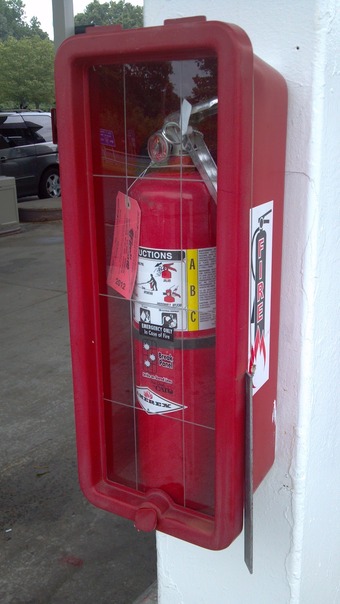
Fire extinguisher
This is a classic example of an unsought good.
The purchase of these goods may not be immediate and can be deferred. Hence, unsought goods require advertising and personal-selling support, and extensive marketing in other areas as well. Marketers have classified products on the basis of durability, tangibility, and use (consumer or industrial).
Converting Unsought Goods to Sought Goods
In the past, new products such as frozen food items were unsought—why buy frozen when you can buy fresh?—until they were advertised extensively in innovative ways. Once the consumer is well-educated about the product, the good goes on to become a sought good.
For example: A new smartphone with exclusive features is an unsought good until the consumer hears about it. Once the smartphone is widely known among customers, it becomes a sought good. A classic example here is the Apple iPhone. Consumers are unaware that they want it unless they are told about it. Another example to note would be life insurance. Even though it is a classic example of an unsought good, it is quickly growing into a sought good. With the conversion of life insurance from just insurance to an investment idea for your future, this good has shifted paradigms.
Sauerkraut, or cabbage prepared in a particular way, was common as food given to American solders during Word War I. However, due to concerns the American public would reject a product with a German name, American sauerkraut makers relabeled their product as “Liberty cabbage” for the duration of the war. This was to prevent the good from becoming an unsought good. A similar case was that of organ meats during World War II: the American public initially rejected hearts, livers, etc., which were required due to food shortages. However, marketers successfully changed the perception of such organ meats, so that they became desirable.
9.2.5: Business Products
Business products are sold to other businesses, as opposed to convenience, shopping, and specialty products, which are sold to consumers.
Learning Objective
Distinguish between the different types of business products
Key Points
- Business products are marketed differently than convenience, shopping and specialty products, due to their different nature as well as the different nature of the prospective buyers.
- A useful way to divide business products is into farm products and manufactured products, as they are marketed differently.
- There are different types of manufactured products, such as semi-manufactured products, parts, raw materials, and machinery.
Key Term
- business products
-
Products that are sold to other businesses as opposed to end consumers, and used to produce other products.
Example
- Business products can be as diverse as crude oil, wood, machinery, photocopiers, and paper.
Business products represent a very important product category, and in the case of some manufacturers, they are the only product sold. These are goods that are sold to other businesses, and used to produce other goods. Industrial products can either be categorized from the perspective of the producer and how they shop for the product, or from the perspective of the manufacturer, how they are produced and how much they cost. The latter criterium offers a more insightful classification for industrial products.
Manufactured products are those that have undergone some processing. The demands for manufactured industrial goods are usually derived from the demands for ultimate consumer goods. There are a number of specific types of manufactured industrial goods. Semi-manufactured goods are raw materials that have received some processing but require some more before they are useful to the purchaser. Lumber and crude oil are examples of these types of products. Since these products tend to be standardized, there is a strong emphasis on price and vendor reliability.

Business Product
Lumber is an example of a business product.
Parts are manufactured items that are ready to be incorporated into other products. For instance, the motors that go into lawn mowers and steering wheels on new cars are carefully assembled when they arrive at the manufacturing plant. Since products such as these are usually ordered well in advance and in large quantities, price and service are the two most important marketing considerations.
Process machinery (sometimes called “installations”) refers to major pieces of equipment used in the manufacture of other goods. This category would include boilers, lathes, blast furnaces, elevators, and conveyor systems. The marketing process incorporates the efforts of a professional sales force, supported by engineers, technicians, and personalized service.
Equipment is made up of portable factory equipment and office equipment (e.g., computers, copier machines). Although these products do not contribute directly to the physical product, they do aid in the production process. These products may be sold directly from the manufacturer to the user, or a middleman can be used in geographically dispersed markets. The marketing strategy employs a wide range of activities, including product quality and features, price, service vendor deals, and promotion.
Supplies and service are consumed in conjunction with making the product. Supplies include paper, pencils, fuel, oil, brooms, soap, etc. These products are normally purchased as convenience products with a minimum of effort and evaluation. Business services include maintenance, repairs, and advisory. Because the need for services tends to be unpredictable, they are often contracted for a relatively long period of time.
9.3: Product Line and Product Mix
9.3.1: Adjustments to Products
Marketers must often make product adjustments in order to keep the product competitive and continue to provide satisfaction to the buyer.
Learning Objective
Discuss strategies for adjusting products in response to changes in consumer taste and the marketplace
Key Points
- There are risks involved with product adjustment: changing the price of the product may price some buyers out, while changing the features may dissuade some from continuing to buy the product.
- Product positioning is both a concept and a process, often requiring extensive market research and involving a conscious change in the promotional message.
- Line extensions occur when a company adds new items in the same market category. This is usually either up-market or down-market, depending on the company’s strategy and desired market growth.
Key Terms
- product adjustment
-
The changing of a product in order to provide superior satisfaction and win over buyers from other brands and products.
- product repositioning
-
Changing the market’s perceptions of a product so that it may better compete in its present market or other market segments.
Example
- The VW Beetle is an example of a product that has been adjusted and repositioned over the years in response to changes in technology, costs, and customer preferences.
Adjustments to Products
As more brands enter the marketplace, winning and holding buyers becomes more difficult. This is a result of:
- changes in consumer tastes; in particular, the size and characteristics of particular market segments
- changes in availability or cost of raw materials and other production or marketing components
- the proliferation of small-share brands that reduce efficiencies in production, marketing, and servicing for existing brands
Because of factors such as these, a decision is made either to identify ways of adjusting the product in order to further distinguish it from others, or to design a strategy that will eliminate the product and make way for new products. The specific strategy to accomplish these aims may be in several general categories, described below.
Product Adjustment/Modification
It is normal for products to be changed several times during their lives. If a change can provide superior satisfaction and win more initial buyers and switchers from other brands, then a change is probably warranted. Yet there are definite risks involved: a dramatic increase in product quality might price the existing target consumer out of the market. Similarly, the removal of a particular product feature might be the one characteristic of the product considered most important by a market segment.

VW Beetle
The VW Beetle has been modified countless times since its original production in 1930s in order to keep it competitive and attractive to consumers.
A key question the marketer must answer before modifying the product is: “What particular attributes of the product and competing products are perceived as most important by the consumer? ” Factors such as quality, function, price, service, design, packaging, and warranty may all be determinants. This evaluative process requires marketing research studies to learn of improvements buyers might want, evaluate the market reception given to the competitors’s improvements, and evaluate improvements that have been developed within the company.
Also required is a relationship with the product research and development (R&D) department. Ideally, R&D should be able to respond quickly to the marketing department’s requests for product upgrades and should maintain ongoing programs of product improvement and cost reduction.
Product Positioning and Repositioning
Product positioning is a strategic management decision that determines the place a product should occupy in a given market – its market niche. Given this context, the word “positioning” includes several common meanings of position:
- place (what place does the product occupy in its market? )
- rank (how does the product fare against its competitors in various evaluative dimensions? )
- mental attitude (what are consumer attitudes? )
- strategic process (what activities must be attempted in order to create the optimal product position? )
Thus, positioning is both a concept and a process. The positioning process produces a position for the product, just as the segmentation process produces alternative market segments. Positioning can be applied to any type of product at any stage of the lifecycle. Approaches to positioning range from gathering sophisticated market research information on consumers’s preferences and perceptions, to the intuition of the product manager or a member of his or her staff.
Product repositioning involves changing the market’s perceptions of a product or brand so that it can compete more effectively in its present market or in other market segments. Changing market perceptions may require changes in the tangible product or in its selling price. Often, however, the new differentiation is accomplished through a change in the promotional message. To evaluate the position and to generate information about the future positioning strategies, it is necessary to monitor the position over time. A product position may change readily; keeping track and making necessary adjustments is very important.
Product Line Extensions
A product line extension is the use of an established product’s brand name for a new item in the same product category. Line extensions occur when a company introduces additional items in the same product category under the same brand name, such as new flavors, forms, colors, added ingredients, or package sizes. The company can extend its product line down-market, up-market, or in both directions.
Down-Market Stretch: a company positioned in the middle market may want to introduce a lower-priced line for any of three reasons: (a) the company may notice strong growth opportunities as mass retailers such as Wal-Mart attract a growing number of value-seeking shoppers; (b) the company may wish to tie up lower-end competitors who might otherwise try to move up-market; or (c) the company may find that the middle market is stagnating or declining.
Up-Market Stretch: companies may wish to enter the high end of the market for more growth, higher margins, or simply to position themselves as full-line manufacturers. Many markets have spawned surprising upscale segments: Starbucks in coffee, Haagen-Dazs in ice cream, and Evian in bottled water. Leading Japanese auto companies have each introduced an upscale automobile: Toyota’s Lexus, Nissan’s Infiniti, and Honda’s Acura.
9.3.2: Product Line Breadth
The breadth of the product mix consists of all the product lines that the company has to offer to its customers.
Learning Objective
Describe the relationship between product line breadth and the product marketing mix
Key Points
- Product marketers must decide what products will be offered (i.e., the breadth and depth of the product line).
- The product line breadth is one of the four dimensions associated with a company’s product mix.
- The product line breadth is also referred to as the: product width, product assortment width and merchandise breadth.
Key Terms
- product mix
-
The complete set of all products a business offers to a market. The product mix is made up of both product lines and individual products.
- depth of the product line
-
Line depth refers to the number of subcategories a category has.
- product line breadth
-
The breadth of the product mix consists of all the product lines that the company has to offer to its customers.
Example
- If a company has five different product lines: hair products, oral care, soaps and detergents, baby care, and personal care. The product mix breadth is five.
Introduction: Product Marketing Questions
Product marketing in a business addresses five important strategic questions:
- What products will be offered (i.e., the breadth and depth of the product line)?
- Who will be the target customers (i.e., the boundaries of the market segments to be served)?
- How will the products reach those (i.e., the distribution channel and are there viable possibilities that create a solid business model)?
- At what price should the products be offered?
- How will customers be introduced to the products (i.e., advertising)?
In this unit, you’re going to learn about the relationship between the breadth of the product line and the product mix.
Product Line Breadth
The breadth of the product mix consists of all the product lines that the company has to offer to its customers. If we take P&G, for example, the breadth of the major product lines would consists of hair products, oral care, soaps and detergents, baby care, and personal care.
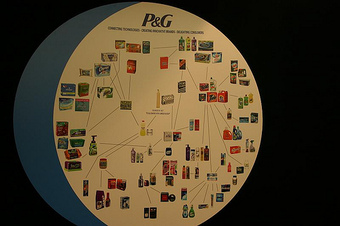
Proctor and Gamble’s Brands
Proctor and Gamble has various product lines.
You may also hear the product line breadth referred to as the product width, product assortment width, and merchandize breadth.
Product Line Breadth and the Product Mix
The product mix of a company is generally defined as the complete set of all products a business offers to a market. The product mix (sometimes called “product assortment”) is made up of both product lines and individual products.
A product line is a group of products within the product mix that are closely related, either because they function in a similar manner, are sold to the same customer groups, are marketed through the same types of outlets or fall within given price ranges.
An individual product is a particular product within a product line. It is a distinct unit within the product line that is distinguishable by size, price, appearance, or some other attribute. For example, all the courses a university offers constitute its product mix, courses in the marketing department constitute a product line, and the principles of marketing course is a product item.
Now, there are four dimensions associated with a company’s product mix and the product line breadth is one of them. The other three are the length, the depth, and the consistency.
Going back in our P&G example we saw five different product lines: hair products, oral care, soaps and detergents, baby care, and personal care. This means that the product mix breadth is five.
9.3.3: Product Line Depth
Companies employ different strategies to expand their product line depth, which refers to the number of products in a specific product line.
Learning Objective
Describe the different tactics for implementing full-line and limited-line product strategies
Key Points
- Companies with full-line strategies attempt to enhance product line depth through carrying a high number of variations on a similar product in order to satisfy a wide range of different customer desires.
- Companies with limited-line strategies will carry a select few product variations with the highest impact, rather than carrying every conceivable variation of the product.
- Line-filling and line-pruning strategies can take place, depending on whether there is a perceived void in the product line, or whether an existing product in the line becomes obsolete or unprofitable.
Key Term
- product line depth
-
Product line depth refers to the number of products in a company’s specific product line.
Example
- A manufacturer of salad dressings will usually produce a number of different flavors in order to satisfy the widely varying tastes of different customers.
A product line can contain one product or hundreds. The number of products in a product line refer to its product line depth, while the number of separate product lines owned by a company is the product line width (or breadth).
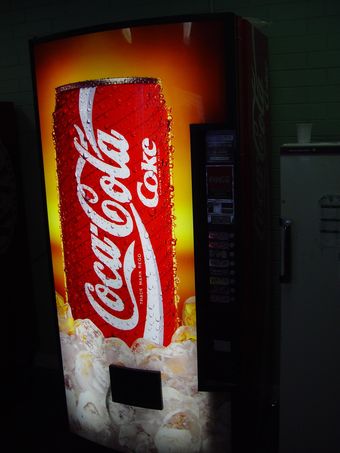
Vending Machine
Soft drink companies tend to produce many variations of a similar products to fill out their product line.
There are two basic strategies that deal with whether the company will attempt to carry every conceivable product needed and wanted by the consumer or whether they will carry selected items. The former is a full-line strategy while the latter is called a limited-line strategy.
Line-filling Strategies
Line-filling strategies occur when a void in the existing product line has not been filled or a new void has developed due to the activities of competitors or the request of consumers. Before considering such a strategy, several key questions should be answered: Can the new product support itself? Will it cannibalize existing products? Will existing outlets be willing to stock it? Will competitors fill the gap if we do not? What will happen if we do not act?
Assuming that the company decides to fill out the product line further, there are several ways of implementing this decision. Three are most common:
- Product proliferation: the introduction of new varieties of the initial product or products that are similar (e.g. a ketchup manufacturer introduces a hickory-flavored sauce, a pizza-flavored barbecue sauce, and a special hot dog sauce)
- Brand extension: strong brand preference allows the company to introduce the related product under the brand umbrella (e.g. Jell-O introduces pie filling and diet desserts under the Jell-O brand name)
- Private branding: producing and distributing a related product under the brand of a distributor or other producers (e.g. Firestone producing a less expensive tire for Kmart)
In addition to the demand of consumers or pressures from competitors, there are other legitimate reasons to engage in these tactics. First, the additional products may have a greater appeal and serve a greater customer base than did the original product. Second, the additional product or brand can create excitement both for the manufacturer and distributor. Third, shelf space taken by the new product means it cannot be used by competitors. Finally, the danger of the original product becoming outmoded is hedged. Yet there is stil serious risk to consider: unless there are markets for proliferation that will expand the brand’s share, the newer forms will cannibalize the original product and depress profits.
Line-pruning Strategies
Line-pruning strategies involve the process of getting rid of products that no longer contribute to company profits. A simple fact of marketing is that sooner or later a product will decline in demand and require pruning. Timex has stopped selling home computers. Hallmark has stopped selling talking cards. A great many of the components used in the latest automobile have replaced far more expensive parts, due to the increased costs in other areas of the process, such as labor.
Using modern robotics technology has halved the manufacturing costs of several products. Through such implementation, Keebler Cookies moved from packaging their cookies totally by hand to 70% automation. Other possible ways a company might become more efficient are by replacing antiquated machinery, moving production closer to the point of sale, subcontracting out part of the manufacturing process, or hiring more productive employees.
9.3.4: Product Lines in Services
By productizing a service it can be managed more like a product and various product lines can be created.
Learning Objective
State the criteria required to productize a service
Key Points
- The service product manager identifies profitable service space, packages services in a productized form, and delivers the same to the market.
- Productizing a service involves the creation of necessary product documentation like executive materials, service product document, technical services document, and service scope.
- Like regular products, service products can be ramped down.
Key Term
- productize
-
To modify something to become suitable as a commercial product.
Example
- In the 1980s IBM productized many services that had previously been free and began selling them for a fee.
Introduction
Consider this scenario: you provide a service, let’s say image consulting. You’ve been in business for quite some time and have been charging an hourly rate. Business has been okay, but you constantly have to defend your rate to clients who benefit from your service but still complain that your rate “seems to be a bit high.” Or maybe they are reluctant to even use your service because they don’t know what they will be getting for that price.
Service providers often have to deal with this problem. There is a solution, however, to productize the service.
How to Productize a Service
Productizing a service means making the service look more like a product so that it is easier for customers to conceive, and thus buy. This involves:
- Giving it a defined scope;
- Putting it into a limited time period;
- Attaching a definite price tag; and
- Giving it a distinctive name.
Going back to the image consulting business, instead of charging an hourly rate, you could productize your service by offering a “One-Day Makeover. ” The product would consist of a:

Productizing
An image consultant can productize their service by offering a package which includes a clothes and accessories shopping trip, beauty salon visit, and make-up application.
- Wardrobe assessment;
- Shopping trip;
- Beauty salon visit; and
- Make-up application tips.
All of this would be offered for a fixed price. And there’s no need to stop there. An entire product line (or lines) could be produced using the same technique.
If you worked for a large corporation and developed a solution such as this, you would be called a Service Product manager.
The Service Product Management
Service Product Management deals with managing a service product throughout its complete life cycle. This organizational function is equally common in business-to-business as well as business-to-consumer organizations.
A service product, unlike a hardware or software product, is intangible, and manifests itself as pure professional services or as a combination of services with necessary software and/or hardware.
The service product management practice ensures management of a profitable service in the marketplace.
The service product manager identifies a profitable service space, packages services in a productized form and delivers the same to the market. The function is a core service business management function and is a mix of sales and marketing functions. The function interfaces with various organizational groups like strategy, planning, financial controls /management accounting, sales, marketing and communications.
9.4: Product Life Cycles
9.4.1: The Product Life Cycle
Every product goes through the various life cycle phases of introduction, growth, maturity and decline.
Learning Objective
Discuss the rationale behind the marketing concept of product life cycles
Key Points
- Depending on its current stage in the product life cycle, a product will have different marketing, financing, manufacturing, purchasing and human resource requirements.
- In the market introduction stage (following product development), the product is released on to the market.
- Sales are low and costs are high in the market introduction stage, thus, no profits are made. There is little to no competition and demand must be created through heavy promotion.
Key Terms
- decline stage
-
when a product is not predicted to continue to be successful or upgraded
- product life cycle
-
The process wherein a product is introduced to a market, grows in popularity, and is then removed as demand drops gradually to zero.
- maturity stage
-
when a product is no longer in the growth stage, but not yet in the decline stage
Example
- Product development and product life cycles go hand-in-hand. It is important that businesses continually develop new products to replace those that are declining. For example, consider the product development and life cycle of a video game. Often the games take 2 to 4 years to develop. Once they are released on to the market, their product life cycle is usually about 6 months.
Product Life Cycle: Overview
The product life cycle (PLC) describes the life of a product in the market with respect to business/commercial costs and sales measures. It proceeds through multiple phases, involves many professional disciplines and requires a multitude of skills, tools and processes.
This is not to say that product lives cannot be extended – there are many good examples of this – but rather, each product has a ‘natural’ life through which it is expected to pass.
The stages of the product life cycle are:
- Introduction
- Growth
- Maturity
- Decline
PLC management makes these three assumptions:
- Products have a limited life and, thus, every product has a life cycle.
- Product sales pass through distinct stages, each of which poses different challenges, problems and opportunities to its parent company.
- Products will have different marketing, financing, manufacturing, purchasing and human resource requirements at the various stages of its life cycle.
The product life cycle begins with the introduction stage (see ). Just because a product successfully completes the launch stage and starts its life cycle, the company cannot take its success for granted.
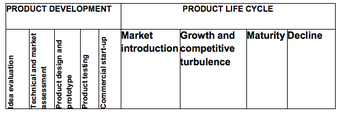
Product Development and Product Life Cycle
The Product Life Cycle follows directly after new product development.
A company must succeed at both developing new products and managing them in the face of changing tastes, technologies and competition. A good product manager should find new products to replace those that are in the declining stage of their life cycles; learning how to manage products optimally as they move from one stage to the next.
Product Lifecycle Management Stage 1: Market Introduction
This stage is characterized by a low growth rate of sales as the product is newly launched and consumers may not know much about it. Traditionally, a company usually incurs losses rather than profits during this phase. Especially if the product is new on the market, users may not be aware of its true potential, necessitating widespread information and advertising campaigns through various media.
However, this stage also offers its share of opportunities. For example, there may be less competition. In some instances, a monopoly may be created if the product proves very effective and is in great demand.
Characteristics of the introduction stage are:
- High costs due to initial marketing, advertising, distribution and so on.
- Sales volumes are low, increasing slowly
- There may be little to no competition
- Demand must be created through promotion and awareness campaigns
- Customers must be prompted to try the product.
- Little or no profit is made owing to high costs and low sales volumes
9.4.2: Growth
During the growth stage, the public becomes more aware of the product; as sales and revenues start to increase, profits begin to accrue.
Learning Objective
Identify the conditions that exist when a product is in stage 2, growth of the Product Life Cycle
Key Points
- Initial distribution is expanded as popularity increases, leading to increases in promotion as well.
- The company often looks at introduction improvements and innovations so as to cement their position in this stage, and discourage competitors from having any success in copying the product and selling substitutes.
- Increased competition in this stage may lead to falling prices as the company competes with others to gain and keep hold of market share.
Key Term
- growth stage
-
The stage of the product life cycle where product sales, revenues and profits begin to grow as the product becomes more popular and accepted in the market.
Example
- Mini tablets, such as the iPad mini, Google Nexus 7, or Amazon Kindle Fire, are in the growth stage at the moment. The concept of having a tablet larger than a smart phone but smaller than a full-sized tablet (such as an iPad) is relatively new, and companies such as Amazon and Apple are in the stage where they are attempting to convince users to switch use them. While Apple has often been a market leader in innovations, it has lagged behind in the case of mini tablets, and this may cause it lose out on market leader status and instead play catch up.
The stages of the product life cycle are:
- Introduction
- Growth
- Maturity
- Decline
Product Lifecycle Management Stage 2: Growth
The growth stage is the period during which the product eventually and increasingly gains acceptance among consumers, the industry, and the wider general public. During this stage, the product or the innovation becomes accepted in the market, and as a result sales and revenues start to increase . Profits begin to be generated, though the break even point is likely to remain unbreached for a significant time–even until the next stage, depending on the cost and revenue structures.
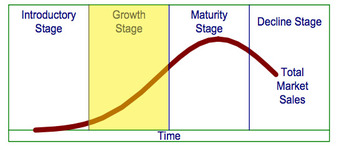
Growth Stage
The graph shows the growth stage in the overall product life cycle.
Initial distribution is expanded further as demand starts to rise. Promotion is increased beyond the initially high levels, and word-of-mouth advertising leads to more and more potential customers hearing about the product, trying it out, and–if the company is lucky–choosing to use the product regularly. Repeat orders from initial buyers are also obtained.
If a monopoly was initially created, then it still exists in this stage. Because of this, the manufacturing company can look at ways to introduce new features, alterations, or other types of innovation to the product according to feedback from consumers and from the market in general. This would be done in order to maintain growth in sales and ensure that interest in the product continues to grow and not stagnate, thus maintaining the growth stage. In fact, the growth stage is seen as the best time to introduce product innovations, as it creates a positive image of the product and diminishes the presence of competitors who will be attempting to copy or improve the product, and present their own products as a substitute.
Features of the growth stage:
- Costs reduced due to economies of scale: as production and distribution are ramped up, economies of scale kick in and reduce the per unit costs.
- Sales volume increases significantly: as the product increases in popularity, sales volumes increase.
- Profitability begins to rise: revenues begin to exceed costs, creating profit for the company
- Public awareness increases: through increased promotion, visibility and word of mouth, public awareness grows.
- Competition begins to increase with a few new players in establishing market
- Increased competition leads to price decreases: price wars may erupt, technology may get cheaper, or other factors can ultimately lead to falling prices.
9.4.3: Maturity
During the maturity stage, sales will peak as the product reaches market saturation, and competition will grow increasingly fierce.
Learning Objective
Identify the market conditions of a product in stage 3, maturity of the product life cycle.
Key Points
- As the company will attempt to prolong the maturity phase as long as possible, it will likely introduce alterations and innovations to the product to keep customers interested and stay a step ahead of the competition.
- Advances in technology and changes in consumer taste and demand may also add to the slowing down of sales growth of the product during this phase.
- Prices tend to drop in this phase due to lower costs as well as a high level of competition, and so industrial profits will fall as well.
Key Terms
- market saturation
-
A situation in which a product has become distributed within a market to the fullest possible extent, leaving demand for the product at a minimum. The actual level of saturation can depend on consumer purchasing power, competition, prices, and technology.
- maturity
-
The stage in the product life cycle where sales growth ultimately peaks, then slows as the product reaches widespread acceptance, and competition is fierce.
Example
- Many popular and known products, such as the iPod and the iPhone, are in the maturity phase at the moment. Apple managed to extend the maturity phase of the iPod by introducing the iPod touch, which introduced a touch screen and new features. It also introduced new functionalities such as the use of apps, making it much more versatile and useful than the older iPods; one could argue that the iPod touch should be considered an entirely new product rather than an innovation on earlier iPod models.
The stages of the product life cycle are:
- Introduction
- Growth
- Maturity
- Decline
Product Lifecycle Management Stage 3: Maturity
The maturity stage follows the growth stage in the product’s life cycle (see ).
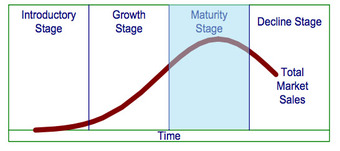
Maturity Stage
The maturity stage of the product life cycle shows that sales will eventually peak and then slow down.
During this stage, sales growth has started to slow down, and the product has already reached widespread acceptance in the market, in relative terms. Ultimately, during this stage, sales will peak. The company will want to prolong this phase so as to avoid decline, and this desire leads to new innovation and features in order to continue to compete with the competition which, by now, has become very established, advanced and fierce. Competitors’ products will begin to cut deeply into the company’s market position and market share. However, despite this, sales continue to grow in the early part of the maturity phase. But, these sales will peak and ultimately decline, as the graph shows.
Demand for the product ultimately decreases due to competition and market saturation, as well as new technologies and changes in consumer tastes. Actions the company takes may include:
- Improving specific features in order to resell the product (for instance, in the case of a car, the manufacturer may include alloy wheels, new colors, sport or hybrid versions, or other changes in order to keep sales going);
- Lowering prices in order to fight off competition;
- Intensifying distribution and promotional efforts;
- Differentiation efforts, in the hope that new customers will start to buy the product.
- Finding a new targeted market.
The stage that lasts the longest in the product life cycle is the Maturity stage. It is at this time that repeat business and purchases take the place of new customer buying. So, during the maturity stage, the following occurs:
- Costs are lowered as a result of production volumes increasing and experience curve effects
- Sales volume peaks and market saturation is reached
- Increase in numbers of competitors entering the market
- Prices tend to drop due to the proliferation of competing products
- Brand differentiation and feature diversification is emphasized to maintain or increase market share
- Industrial profits go down
9.4.4: Decline
During decline, sales growth becomes negative, profits decline, competition remains high, and the product ultimately reaches its ‘death’.
Learning Objective
Identify the characteristics of a product in the decline stage of the product life cycle.
Key Points
- Sales volume declines as competition becomes too strong for the company in question; as well as the fact that changes in consumer tastes and new technologies also erode sales.
- Maintaining profitability increasingly becomes more about efficiency of production and distribution rather than about increasing sales.
- Usually, product termination is not about the end of the business cycle or the entire product class; rather, it is about the termination of a single product or market entrant that can no longer compete as it has reached the end of its life.
Key Term
- decline
-
The stage of the product life style where low/negative sales growth, lower profits, and maximum competition occur, forcing the product into decline and ‘death’.
The stages of the product life cycle are:
- Introduction
- Growth
- Maturity
- Decline
Product Lifecycle Management Stage 4: Decline
The decline stage of the product life cycle is the one where the product ultimately ‘dies’ due to the low or negative growth rate in sales (see ).
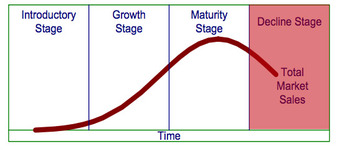
Decline Stage
The decline stage of the product life cycle is the terminal stage where sales drop and production is ultimately halted.
Profitability will fall, eventually to the point where it is no longer profitable to produce, and production will stop. As a number of companies start to dominate the market, it becomes increasingly difficult for the company in question to maintain its level of sales. Consumer tastes also change, as do new technologies which may make the product become ultimately obsolete (as in the case of CDs and DVDs, and now Blu-Ray).
Features of the decline stage include:
- A decline in sales volume as competition becomes severe, and popularity of the product falls;
- A fall in prices and profitability (the latter ultimately moving in the negative zone);
- A counter-optimal cost structure;
- Profit increasingly becomes a challenge of production/distribution efficiency rather than increased sales.
It is important to note that product termination is not usually the end of the business cycle; rather, it is only the end of a single entrant within the larger scope of an on-going business program.
Example: The Personal Computer (PC)
shows the actual sales and price of the personal computer from 1992 to 2002. The PC was state-of-the-art technology in 1992. Only technologically-advanced individuals would buy one at the very steep price of $1800 (and bear in mind, $1800 in 1992 was worth a lot more than it is today). A large number of companies were competing in the field. As the market grew, businesses learned to be more efficient in producing the PC and prices came down. The drop in prices and improvements in technology made PCs more attractive to other consumers. However, the market became saturated after 2000 and went into decline. PCs started to become obsolete as laptops, net books, tablets, and smart phones started to enter the market, shifting the emphasis from power to portability. The PC is still used all over the world, but its popularity has declined dramatically.
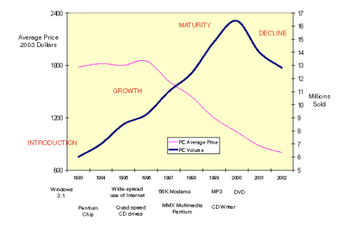
Product life cycle of the personal computer
The chart shows the rise and fall of personal computers.
9.4.5: Product Life-Cycle Curve
Product life cycles are a useful guide to lifetime sales and profits, and can help marketers understand what strategies to deploy & when.
Learning Objective
Discuss characteristics of a product’s life cycle curve
Key Points
- Different products will have differently shaped product life cycle curves. Products like Coke and Pepsi seem to be in a permanent maturity phase, while fads like the Tamagochi have short maturities as well as steep introduction and decline phases.
- Some products have very unpredictable product life cycles owing to high levels of uncertainty and risk. For these, the product life cycle model is less useful.
- During the early stages of the product life cycle, a product will not be highly profitable. Thus, the maturity stage should be extended as long as possible.
Key Term
- fad
-
A phenomenon that becomes popular for a very short time; the product life cycle has a steeply-sloped growth stage, a short maturity stage, and a very steep decline.
Understanding Product Life Cycle Curves
It is important for marketing managers to understand the limitations of the product life cycle model. A rise in sales per se is not necessarily evidence of growth, just as a fall in sales does not typify decline. Some products like Coca Cola and Pepsi may not experience a decline at all.
Differing products possess different product life cycle “shapes. ” A fad product develops as a steeply-sloped growth stage, a short maturity stage, and a steeply-sloped decline stage (for instance, the pet rock phase in the 1970s). A product like Coca-Cola and Pepsi experiences growth, but also a constant level of sales over decades. A given product may hold a unique product life cycle shape such that use of typical product life cycle models are useful only as a rough guide for marketing management.
The duration of each product’s life cycle stage is unpredictable, making it difficult to detect when maturity or decline has begun. Due to these limitations, strict adherence to the product life cycle model can lead a company to misleading objectives and strategy prescriptions.
Rather, the product life cycle model should be used as a rough guide to predict how sales patterns may play out given competitive and economic conditions. All in all, it is a useful model, but not a certainty.
The two charts and demonstrate the break-even point reached during the product life cycle as well as sales and profits in general. They show that the product does not make much profit during early periods of the life cycle, meaning the maturity stage must be extended to maximise profits.
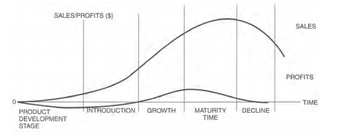
Sales and Profits
The diagram shows the sales and profits of a given product during the course of the product life cycle.

Break Even
The diagram shows when a product is expected to break even once it is introduced into the market.
Examples
Facebook is in the mature phase of the product life cycle. Once it became the norm for everyone to have a Facebook account, the growth stage passed. No new or obsoleting technology is expected to appear soon which would put Facebook out of business. While Facebook competes with other social media sites like Google+ and Twitter, it appears to be holding its own. Thus, we can say that Facebook is comfortably in the maturity stage.
iPod
The iPod touch is currently in the mature phase of the product life cycle. This is because the iPod touch is just an evolution of a product that has been around for long time. Competitors like Microsoft’s Zune have just followed Apple’s design and technology, while the iPod has evolved over multiple “generations,” each adding new features and functionalities. Today, the iPod touch is more than just a music player; it plays videos, runs apps and can be used as an organizer. Such a product may be difficult to classify using the product life cycle model – is it the same old iPod, or an entirely new product?
9.4.6: Impact of the Product Life Cycle on Marketing Strategy
The stage of the life cycle of the product affects how it is marketed.
Learning Objective
Summarize marketing strategies that apply to product life cycles
Key Points
- During the introduction stage, the product is promoted to create awareness and develop a market for the product.
- In the growth stage, the firm seeks to build brand preference and increase market share.
- The primary objective during the maturity phase is to defend market share while maximizing profit.
- Firms have several options when deciding how to deal with a product in the decline phase.
- Marketers must take care not to miss opportunities by following strategies based on the product life cycle model too closely.
Key Term
- product life cycle
-
The process wherein a product is introduced to a market, grows in popularity, and is then removed as demand drops gradually to zero.
Introduction
The stages through which individual products develop over time is called commonly known as the “Product Life Cycle.”

Product Life Cycle Stages
The table shows the product life cycle stages and the different marketing characteristics that accompany and identify them.
The product life cycle is a well-known framework in marketing. Products typically go through four stages:
- Introduction
- Growth
- Maturity
- Decline
After a period of development, the product is introduced or launched into the market. It gains more and more customers as it grows and, eventually, the market stabilizes and the product becomes mature. Then after a period of time, the product is overtaken by development and the introduction of superior competitors, goes into decline, and is eventually withdrawn.
At each stage, marketing strategy varies.
Strategies for the Different Stages of the Product Life Cycle
Introduction
The need for immediate profit is not a pressure. The product is promoted to create awareness and develop a market for the product. The impact on the marketing mix and strategy is as follows:
- Product branding and quality level is established and intellectual property protection, such as patents and trademarks are obtained.
- Pricing may be low penetration to build market share rapidly or high skim pricing to recover development costs.
- Distribution is selective until consumers show acceptance of the product.
- Promotion is aimed at innovators and early adopters. Marketing communications seeks to build product awareness and educate potential consumers about the product.
Growth
Competitors are attracted into the market with very similar offerings. In the growth stage, the firm seeks to build brand preference and increase market share.
- Product quality is maintained and additional features and support services may be added.
- Pricing is maintained as the firm enjoys increasing demand with little competition.
- Distribution channels are added as demand increases and customers accept the product.
- Promotion is aimed at a broader audience.
Maturity
Those products that survive the earlier stages tend to spend longest in this phase. At maturity, the strong growth in sales diminishes. Competition may appear with similar products. The primary objective at this point is to defend market share while maximizing profit.
- Product features may be enhanced to differentiate the product from that of competitors.
- Pricing may be lower because of the new competition.
- Distribution becomes more intensive, and incentives may be offered to encourage preference over competing products.
- Promotion emphasizes product differentiation.
Decline
At this point, there is a downturn in the market. For example, more innovative products are introduced or consumer tastes have changed. There is intense price cutting, and many more products are withdrawn from the market. Profits can be improved by reducing marketing spending and cost cutting.
As sales decline, the firm has several options:
- Maintain the product, possibly rejuvenating it by adding new features and finding new uses.
- Harvest the product–reduce costs and continue to offer it, possibly to a loyal niche segment.
- Discontinue the product, liquidating remaining inventory or selling it to another firm that is willing to continue the product.
By imaginatively repositioning their products, companies can change how customers mentally categorize them. They can rescue products struggling in the maturity phase of their life cycles and get them back to the growth phase. And in some cases, they might be able take their new products forward straight into the growth phase.
The Con of Using Product Life Cycles to Direct Strategies
According to Harvard Business School professor Youngme Moon, though the product life cycle concept has been used successfully over the past 40 years, it has made marketers assume that there is only one trajectory for successful products. By viewing the product life cycle in the same way, marketers pursue similar positioning strategies for products and services during each stage of the life cycle. In the process, they miss out on opportunities to differentiate themselves.
9.5: Managing Existing Products
9.5.1: When to Extend Product Lines
A company can extend its product line using a down-market stretch, an up-market stretch, or a move both ways.
Learning Objective
Describe the nature of a product line extension
Key Points
- A line extension should only be considered when the producer can profitably produce a product that compares well with the base product.
- Changing market environmental factors often indicate when the timing suites a product line extension.
- The environmental cues help organizations determine if they should stretch down-market, up-market, or both ways.
Key Term
- product line
-
A product line is the marketing strategy of offering several related products for sale as individual units.
Example
- A company may notice strong growth opportunities as mass retailers such as Wal-Mart, Best Buy, and others attract a growing number of shoppers who want value-priced goods and decide to extend a product line to meet this demand.
Introduction
A product line extension is the use of an established product’s brand name for a new item in the same product platform. Thus, line extension occurs when the company lengthens its product line beyond its current range. The company can extend its product line with a down-market stretch, an up-market stretch, or a move both ways.
Down-Market Stretch
A company positioned in the middle market may want to introduce a lower-priced line for any of the three reasons:
- The company may notice strong growth opportunities as mass retailers such as Wal-Mart, Best Buy, and others attract a growing number of shoppers who want value-priced goods;
- The company may wish to tie up lower-end competitors who might otherwise try to move up-market. If the company has been attacked by a low-end competitor, it often decides to counterattack by entering the low end of the market;
- The company may find that the middle market is stagnating or declining.
Up-Market Stretch
Companies may wish to enter the high end of the market for more growth, higher margins, or simply to position themselves as full-line manufacturers. Many markets have spawned surprising upscale segments:
- Starbucks in coffee;
- Haagen-Dazs in ice cream; and
- Evian in bottled water.
Leading Japanese auto companies have each introduced an upscale automobile:
- Toyota’s Lexus;
- Nissan’s Infiniti; and
- Honda’s Acura.
Note that the companies invented entirely new names rather than using or including their own names
Two-Way Stretch
Companies serving the middle market might decide to stretch their line in both directions. Texas Instruments (TI) introduced its first calculators in the medium-price-medium-quality end of the market. Gradually, it added calculators at the lower end taking the share from Bowmar, and at the higher end to compete with Hewlett-Packard. This two-way stretch won Texas Instruments (TI) an early market leadership in the hand-calculator market.
Examples include:
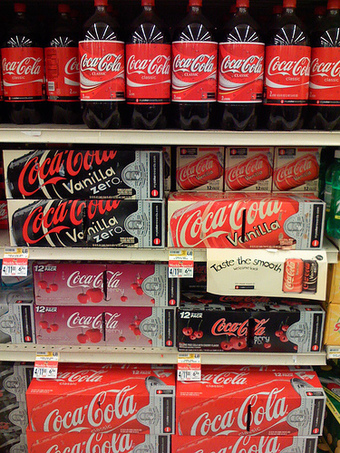
Take Your Pick
Coca-Cola’s product line offers a variety of Coke flavors.
- Zen LXI, Zen VXI;
- Surf, Surf Excel, Surf Excel Blue;
- Splendour, Splendour Plus;
- Coca-Cola, Diet Coke, Vanilla Coke;
- Clinic All Clear, Clinic Plus; and
- Reese’s Peanut Butter Cups, Reese’s Pieces and Reese’s Puff Cereal.
A line extension strategy should only be considered when the producer is certain that the capability exists to efficiently manufacture a product that compares well with the base product. The producer should also be sure of profitable competition in this new market.
9.5.2: When to Modify Products
While the decision to modify products happens ideally at the design stage, products can be changed during any phase of the life cycle.
Learning Objective
Name the external factors that can influence product development
Key Points
- Products are modified to compete more effectively in the market, and appeal to evolving consumer and business demands.
- Multiple stakeholders ranging from employees and customers can influence product modifications.
- Product time, cost, visual appeal, usability and reliability are all factors that influence how and when a product is modified.
- External influences often prompt manufacturers to modify products. These are usually driven by competitive pressures, globalization, new technologies, or unexpected and significant events.
Key Terms
- modified rebuy
-
the repurchase of a good with changes to the details of the order
- stakeholders
-
A person or organization with a legitimate interest in a given situation, action or enterprise. It can range from employees and investors of a company to the customers purchasing from the company.
- iterative
-
Of a procedure that involves repetition of steps (iteration) to achieve the desired outcome; in computing this may involve a mechanism such as a loop.
- recall
-
To withdraw, retract (one’s words etc. ); to revoke (an order).
Example
- Large companies, in particular food producers, will slightly alter a product to attract new attention to it. For example, a soft drink company can produce a limited edition flavor of the product to renew sales levels and give it continuing interest.
When to Modify Products
The product life cycle (PLC) encompasses the multiple phases products pass through during their ‘life’ in the market. Products travel through market introduction, growth, maturity, saturation and decline, posing different challenges, opportunities and problems to manufacturers and sellers depending on industry and target audience. At some point during the life cycle, products may be modified to compete more effectively in the market, and appeal to evolving consumer and business demand .
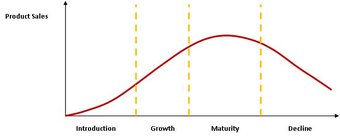
Phases in the Product Life Cycle
Modification decisions often (but not always) happen before products are introduced to the market.
Product Design Stage
At the design stage, developers and engineers must assess the importance of various requirements from a wide range sources. Stakeholders typically contribute input during product development, demanding something different from the product designer and design process.
Factors that can influence whether products are modified at the design stage include:
- Overall production time and cost
- Price, appearance, and prestige value
- Usability and functionality
- Assembly and reliability
Stakeholders’ needs vary from one another and it is the product designer’s job to incorporate those needs into their design. Product design is an iterative process, and often needs to be modified due to manufacturing constraints or conflicting requirements. Where a customer order fits into the timeline depends on the industry type and whether the products are for example, built to order, engineered to order, or assembled to order.
Market Influences
Although product manufacturers painstakingly consider numerous details and possibilities of what could go wrong, many new designs ultimately fail or become obsolete. These product failures usually go back to the manufacturer for modifications, and are later re-introduced to the market. Other products are never re-introduced and deleted entirely from the product roadmap. Product development can take as many as five to six attempts before achieving success in the marketplace.
Innovation provides much of the competitive impetus for the development of new products, with new technology often requiring a new design interpretation. It only takes one manufacturer to create a new product paradigm to force the rest of the industry to catch up, fueling further innovation. While some products are completely new innovations, others are simply minor modifications to existing products.
New and rapidly changing technologies, evolving trends, increased demand and globalization are all factors that play into the decision to add product features and functionality. Unpredictable forces such as mass contamination can lead to product recalls, and the modification or destruction of large quantities of products. In 2007, millions of toys manufactured in China were recalled due to discoveries of lead paint and fears of lead poisoning in children. Product recalls, which can happen at any stage of a product life cycle, are costly and can severely damage a brand’s reputation if managed poorly.
9.6: New Product Development
9.6.1: The Need for New Products
In dynamic markets companies must constantly introduce new products and services to keep up with changing consumer wants and needs.
Learning Objective
Discuss the common challenges of developing successful new products
Key Points
- A company must establish a series of successful products over time if it wants to maintain a consistent stream of sales, or grow sales over time.
- New product generation involves multiple stages and a high level of financial investment, and has no guarantee of success.
- When a new product is introduced, companies must still convince buyers to adopt them into their routines, in order for sales to be consistent.
- Innovation may be ‘continuous’ or ‘discontinuous’ – the former occurring in established markets, while the latter has the potential to create new markets or consumer behaviors.
Key Terms
- planned obsolescence
-
a policy of deliberately planning or designing a product with a limited useful life, so it will become obsolete or nonfunctional after a certain period
- obsolescence
-
The process of becoming obsolete, outmoded or out of date.
- innovation
-
As used here, innovation describes an idea or product that is new to the company in question.
- new product
-
a good or service that was previously not offered by the company
The marketplace is never static: it is dynamic and fast changing, and demand for products is constantly shifting as needs, wants, and technology all change. As a result, companies must always evaluate their existing product line and look for ways to ensure that it is up to date and in line with consumer desires. Continuous decisions must be made about whether new products should be added (and whether old products should be removed).
For instance, the graph in shows how an organization must establish a series of successful products if it wants to maintain a consistent stream of sales, or grow sales over time. As shown in the graph, no product lasts forever, and sales levels can fluctuate dramatically over time. This fictitious company has marketed eight different products over time.
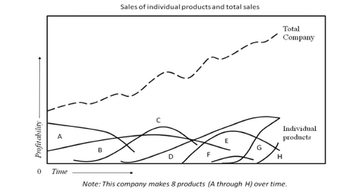
Company Sales
Sales of individual products and total company sales for a fictitious company with multiple products.
In the past, four of these products have been deleted as they near obsolescence (the products labeled as A, B, C, and F). As a result, the sales level in the most current period depends upon the success of the remaining four products. If the firm has a goal to increase sales in the coming years, then it is imperative for that firm to introduce a new group of successful products.
Organizations invest a lot of money to create new products that perform effectively. Nonetheless, firms often struggle to convince people to try out these products, and to use them on a regular basis (and thus incorporate them into their habits and routines). For example, it took 18 years for microwave ovens to gain acceptance in Greece. The ultimate success of new products depends on consumers accepting them.
Innovation
‘Innovation’ is used here to describe an idea or product that is new to the company. A ‘continuous innovation’ introduces a new entrant into an existing category, and does not challenge established patterns of consumer behavior. An example of this is a new, technologically advanced cell phone. A ‘discontinuous innovation’ may alter existing consumption patterns, and even create new ones. For example, portable audio equipment has evolved from the radio, to the cassette tape player, to the compact disk player, and to the digital audio player – and now, to Cloud-based systems. Discontinuous innovation has the potential to radically shift consumer habits and thus create new demand for a whole category of products and services, but understandably entails more risk for the organization.
9.6.2: Strategy
A good NPDS can help organize research, prioritize customer needs, and reduce cost overruns, to ensure a smooth development process.
Learning Objective
Describe the three common approaches to strategically developing new products
Key Points
- Three common approaches to NPDS are user-centered design, flexible product development, and the phase-gate model. There are many other approaches used as well, and what approach to use depends on the nature of the management, the product, and the market.
- User-centered design emphasizes the wants, desires and limitations of the end-user in designing how to develop the product.
- Flexible product development emphasizes a flexible development process, instead of focusing on users as user-centered design does. By making the process as flexible as possible, necessary changes can take place very late in the development process with minimum disruption.
- The phase-gate model separates the different phases by using “gates”–at each gate, a steering committee uses all available information to decide whether to proceed with the development process or not.
Key Terms
- flexible product development
-
A new product development strategy designed so that changes can be made late in the process without excessive disruption.
- user-centered design
-
A new product development strategy where the needs of the end users are given the most attention.
- Phase-gate model
-
A new product development strategy that is divided into phases, separated by gates.
New Product Development Strategy
A well thought out new product development strategy (NPDS) helps a company avoid wasting time and resources by helping to organize planning and research, understanding customer expectations, and accurately resourcing the project. By avoiding common errors such as overestimating the target market, incorrectly setting the price, and accruing higher than predicted costs, a NPDS helps the product to be developed and launched as planned.
The nature of the business and the product in question will determine the NPDS, and what steps need to be taken. Certain steps may be iterated as needed, and others may be eliminated. To speed up the process, many companies complete several steps at the same time (known as “time to market”). For some more complicated products, a large amount of uncertainty makes it impossible to plan the complete project before starting it, and thus a flexible approach is required.
There are many different ways to approaching NPDS. Some of the more common ways are described below.
User-Centered Design (UCD)
Here, the needs, wants and limitations of end users of a product are given a great deal of attention at each stage of the design process. The main element in this process is that user-centered design tries to optimize the product around how users can, want, or need to use the product, rather than forcing users to change their behaviors to accomodate the product.
Flexible Product Development
Flexible product development is the ability to make changes in the product being developed or in how it is developed, even relatively late in development, without being too disruptive. Flexibility is important because the development of a new product naturally involves change from what came before it. Change can be expected in what the customer wants and how the customer might use the product, in how competitors might respond, and in the new technologies being applied in the product or in its manufacturing process. The more innovative a new product is, the more likely it is that the development team will have to make changes during development.
Flexible development counteracts the tendencies of many contemporary management approaches to plan a project completely at its outset and discourage change thereafter. These include Six Sigma, which aims to drive variation out of a process; Lean, which acts to drive out waste; and traditional project management and phased development systems (including the popular Phase–gate model, discussed next), which encourage upfront planning and following the plan. Although these methodologies have strengths, their side effect is encouraging rigidity in a process that needs flexibility to be effective, especially for truly innovative products. Flexibility techniques must be used with discretion, for instance, only in the portions of a product likely to undergo change, in order to minimize potential disruptions, delays, and cost overruns.

Six Sigma
The symbol for Six Sigma, which is a contemporary management approach.
Phase-Gate Model
In a phase–gate model, also referred to as a phase–gate process, the process is divided into stages or phases, separated by gates. At each gate, the continuation of the process is decided by (typically) a manager or a steering committee. The decision is based on the information available at the time, including the business case, risk analysis, and availability of necessary resources (e.g., money, people with correct competencies). The phase–gate model may also be known as stage-limited commitment or creeping commitment.
9.6.3: Idea Generation
The success of product-driven companies is directly tied to new product development, which is generated through innovative ideas.
Learning Objective
Identify the five primary sources of product innovation
Key Points
- The five main sources of innovation are technological breakthough, non-technological development, environment, serendipity, and purposeful development.
- It is possible to create new ideas and new ways of producing products through non-technical means. This would involve using well-known business models and slightly modifying the production process to appear unique.
- The process of serendipity frequently occurs due to government funding of general and scientific research, causing technological and other spillovers into the commercial realm. These spill over effects generate new ideas for products that would have otherwise not been discovered.
Key Terms
- Generation X
-
the generation of people born after the baby boom that followed World War II, especially those born in the 1960s and 1970s
- SWOT Analysis
-
A structured planning method used to evaluate the strengths, weaknesses, opportunities, and threats involved in a project or in a business venture.
- purposeful development
-
Innovation that occurs in response to a market need that existing product lines cannot satisfy.
Idea Generation
Ideas for new products can be obtained from basic research using a SWOT analysis. Market and consumer trends, R&D departments, competitors, focus groups, etc. may also be used to get an insight into new product lines or product features. New product innovations are responsible for employment, economic growth, technological process, and high standards of living. Innovation is crucial for the development of successful new products. Described below are different sources of innovation that lead to the generation of ideas for new products.
Sources of Innovation that Generate Ideas
While innovation is crucially important to any forward-thinking organization, developing and evaluating innovations is a challenge. Where do innovative ideas come from? Discussed below are five crucial sources of innovation: technical breakthrough, non-technical idea development, environment, serendipity, and purposeful development. These are discussed in turn below (see ).

Different Sources of Innovation
A summary of different sources of innovation, as described in this section. Being innovative is key to generating new ideas in product development.
Technical Breakthroughs
Technical breakthroughs refer to product innovations that result from technical developments. New brands that have emerged from this process include MP3 players, GPS navigation devices, and cell phones. Technological breakthroughs are often born in R&D departments or through government funding of research, which ultimately lends itself to commercial uses.
Non-technical Development
This approach involves finding a niche in the market without making radical changes to the basic product category (i.e., in terms of the underlying technology). “Build a Bear Workshop” provides a good example of this style of innovation: Unlike other conventional stuffed animal manufacturers, the Build a Bear Workshop allows customers to choose their bear’s body, sound, clothing, stuffing, and heart. For example, a customer can choose a lower-priced paper heart with their wish, or they can invest in a higher-priced electronic heart. After customers make choices, they then observe the production process in the shop. In this way, customers create their own custom-designed toy. This business model does not rely on developing new technology, but a modified production process and a unique idea that draws the consumer in.
Environment
Certain ideas developed in one environment or geographical location have the potential to do well when imported into new environments. Good examples of this style of innovation are Wal-mart in China and IKEA in the United States–ideas that proved a big hit outside of the cultures that they were traditionally employed in. Large-retail stores are now achieving success in Asian nations, through importing the idea of economies of scale, which in turn enable one-stop shopping and lower prices. Similarly, IKEA achieved great success in the United States through importing the idea of a warehouse-type retail setting from Europe.
Serendipity
Serendipity plays a role in product innovation. The word serendipity derives from “serendip,” which means “Sri Lanka” in Persian. The fairy tale, The Three Princes of Serendip, tells the story of three men who continuously discover something that is completely unrelated to what they originally set out to find. Thus, the term “serendipity” describes a situation where one accidentally discovers something fortunate, while looking for something else entirely. For example, penicillin was discovered quite by accident when Alexander Fleming discovered that a mold contaminating one of his experiments possessed powerful antibacterial properties. While not exactly a strategy that can be purposefully conducted by companies attempting to come up with a specific product, the process of serendipity frequently occurs due to government funding of general and scientific research, causing technological and other spillovers into the commercial realm.
Purposeful Development
Purposeful development occurs when there is a strong need for certain goods or services. As Plato once said, “Necessity is the mother of invention.” In other words, this type of innovation occurs when existing product lines cannot satisfy current needs or current demand. As a result, organizations are willing to invest considerable funds to create a successful innovation. Thus, purposeful development occurs when there is a need that requires satisfaction, as opposed to when demand creation is required for a new product for which there is no initial desire in the marketplace. A good example of purposeful development is the heavy investment that pharmaceutical firms make to discover new prescription drugs.
9.6.4: Screening
During screening, the company evaluates whether to devote further resources to the development of a product at various stage gates.
Learning Objective
Discuss the benefits and shortcomings of product screening
Key Points
- The company must ask itself a number of questions, such as whether there is a potential market for the product, whether the product will meet the demands of the consumer base, and whether the product can be profitable.
- Two major risks arise during screening: an unviable product may be admitted to the next stage, and a potentially successful product may be rejected.
- Products are often rated on a scale from poor to good on a variety of different criteria in order to determine their viability. This process is taken a step further by assigning weights to the criteria, so as to give more importance to factors considered crucial for a product’s success.
Key Term
- screening
-
A step in the product development process where products are evaluated according to a certain set of criteria on whether they will be successful in the marketplace.
Screening
It is important for businesses to continually devise new products, as products do not last forever. While there are millions of products available to consumers, many more products do not make it to market at all. As it is expensive to bring a product to market, products go through a product development process where they are evaluated at every stage before they are brought to commercialization. For example, of the 5,000 drug ideas that go through the screening process of the Federal Drug Administration, only 10 end up getting approved, and of these only 3 become profitable. With an average cost of $1 billion to bring a drug to market, it would take several billion in sales to recoup the cost .
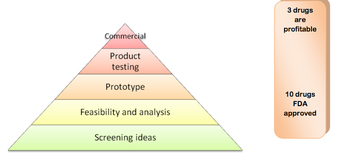
Screening
This figure illustrates the long process it takes for a drug to enter the market.
Screening Objectives
The objective of the screening stage is to eliminate unsound concepts prior to devoting resources to them. The screeners should ask several questions: Will the customer in the target market benefit from the product? What is the size and growth forecast of the target market? What is the current or expected competitive pressure for the product idea? Is it technically feasible to manufacture the product? Will the product be profitable when manufactured and delivered to the customer at the target price? By answering these questions, the company can get a better idea of the likelihood of a product becoming a commercial success.
The screening step is a critical part of the new product development process. Product ideas that do not meet the organization’s objectives should be rejected. Two problems that may arise during the screening stage are the acceptance of a poor product idea, and the rejection of a viable product idea. In the former case, money and effort are wasted in subsequent stages until the product idea is abandoned. In the latter case, a potential winner never sees the market.
Screening Techniques
There are two common techniques for screening new product ideas. Both involve the comparison of a potential product idea against the criteria for acceptable new products. The first technique is a simple checklist. For example, new product ideas can be rated on a scale ranging from very good to poor, in respect to factors such as value added, sales volume, patent protection, and effect on present products. Unfortunately, it is often very challenging for evaluators to define what is fair or poor in any given category. Also, this system does not address the issue of the time and expense associated with each idea, nor does it provide instructions with regard to the scores.
The second technique goes beyond the first in that the criteria are assigned weights based on their importance. These scores are then multiplied by their respective weights and added to yield a total score for the new product idea.
9.6.5: Concept Testing
Concept testing is important for evaluating consumer responses to a product before market introduction.
Learning Objective
Explain concept testing, its disadvantages, and alternative methods used to evaluate consumer behavior toward new concepts
Key Points
- Concept testing can also be useful in altering existing attitudes towards existing products in the market.
- Concept testing uses qualitative and quantitative methods. Concept generation portions of concept testing are generally qualitative, while evaluations, positioning, and product/concept tests are usually quantitative.
- Traditional methods of concept testing faced many shortfalls, including not providing consistent information on the ranking of consumer preferences. However, newer methods are alleviating such issues and providing more useful information.
Key Term
- concept testing
-
The process of evaluating consumer response to a product idea prior to the introduction of the product to the market.
Concept testing
Concept testing is the process of using quantitative and qualitative methods to evaluate consumer response to a product idea prior to the introduction of a product to the market. It is a vital part of the idea screening stage of new product development. It can also be used to generate communication designed to alter consumer attitudes toward existing products. These methods involve the evaluation by consumers of product concepts having certain rational benefits, such as “a detergent that removes stains but is gentle on fabrics,” or non-rational benefits, such as “a shampoo that lets you be yourself.” Concept testing is often performed using field surveys, personal interviews and focus groups, in combination with various quantitative methods.
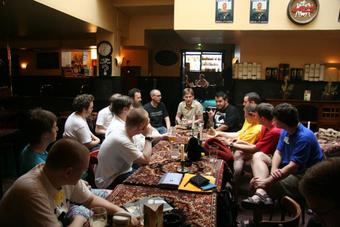
Focus Group
Using focus groups to generate user feedback is one method used to perform concept testing.
The concept generation portions of concept testing are generally qualitative. Advertising professionals create concepts and communications of these concepts for evaluation by consumers, on the basis of consumer surveys and other market research, or on the basis of their own experience as to which concepts they believe represent product ideas that are worthwhile in the consumer market.
The quantitative portions of concept testing procedures have generally been placed in three categories: (1) concept evaluations, where concepts representing product ideas are presented to consumers in verbal or visual form and then quantitatively evaluated by consumers by indicating degrees of purchase intent, likelihood of trial, etc., (2) positioning, which is concept evaluation wherein concepts positioned in the same functional product class are evaluated together, and (3) product/concept tests, where consumers first evaluate a concept, then the corresponding product, and the results are compared.
Shortcomings of Traditional Concept Testing
Traditional systems of concept testing generally failed to provide a systematic, proven way of showing consumer preference of one concept over another. The relative importance of the factors responsible for or governing why consumers, markets and market segments reacted differently to concepts presented to them in the concept tests were not demonstrated. Thus, communication of the concept was generally left to the creativity of the advertising agency, with no systematic quantitative method known or employed that could identify the criteria on which consumer choices were made (at least, not with any real accuracy).
Moore and William (1982), in a literature survey and review of concept testing methodology, point out that concept tests have failed to account for changes between the concept tested and the communication describing the benefits of the product which embodies the concept. The paper reports that “no amount of improvement in current concept testing practices can remedy these problems. ” This is reflective of the fact that none of the traditional methods provided a quantitative means for ascertaining the relative importance of the underlying criteria of concept choices as a means for identifying the visual and verbal expressions of the concepts which best communicate the benefits sought by the consumer. Nor did the traditional methods quantify the relationships between concepts and existing products offered in the same consumer market. The ability of a method to ameliorate or overcome the above shortcomings would provide substantial improvement in communication of the concepts identified in testing and offered to the market as a product.
One such method is conjoint analysis and another is choice modeling. In addition, with online retailing becoming increasingly prominent, many online respondents are also online consumers. Thus, they are able to easily place themselves in the mindset of a consumer looking to buy goods or services. Since the arrival of these methods, market researchers have been able to make better, more accurate, suggestions to their clients regarding the decision to move forward, revise, or start over with a product concept. Online choice modeling, for example, can produce detailed econometric models of demand for various attributes of the new product such as feature, packaging and price.
9.6.6: Business Analysis
The output of the business analysis stage is a prediction about whether the product is likely to be profitable or not if ultimately produced.
Learning Objective
Demonstrate knowledge of the components included in the business analysis stage of product development
Key Points
- The first step in the business analysis process is to examine the likely demand for the product, as well as possible licensing of technologies associated with the product.
- A cost appraisal is also carried out, which involves looking at development costs, management costs, operating costs, set-up costs, and marketing costs.
- Based on the above costs, as well as the level of competition and customer feedback, a selling price and break-even point can be identified.
Key Term
- Fourt-Woodlock equation
-
a market research tool to describe the total volume of consumer product purchases per year based on households which initially make trial purchases of the product and those households which make a repeat purchase within the first year.
Business Analysis
After the initial screening stage, the number of viable proposals available to progress to the next stage will have decreased significantly. However, before the company begins the development of prototypes, there is one more evaluation process that must take place, and this is the business analysis stage. In this stage, additional information is gathered on the remaining innovations in order to decide whether the significant costs that development will require are justified .

Business Analysis
Financial ratio analysis allows an observer to put data provided by a company in context. The observer can gauge the strength of different aspects of the company’s operations.
The primary focus of the business analysis stage is to determine whether the product idea will ultimately be profitable or not. However, while this is the primary consideration, it is not the only consideration. Social and environmental issues are frequently considered as well, particularly if there are certain regulations that the company must adhere to in these realms.
The first step in the business analysis process is to examine the projected demand for the product. While the major source of revenue would be product sales, another possible significant source of revenue is the licensing of the technology generated as a byproduct of the given product. Clearly this is not applicable to all products, but for certain classes of products, this can be a very significant source of income .
A complete cost appraisal is also necessary as part of the business analysis. As you can expect, it is difficult to anticipate all the costs that will be involved in product development. However, the following cost items are typical:
- Expected development cost, including both technical and marketing R&D
- Expected set-up costs (production, equipment, distribution)
- Operating costs that account for possible economies of scale and learning curves
- Marketing costs, especially promotion and distribution
- Management cost
Based on these costs, the business analysis stage will estimate the likely selling price. This figure will also depend on the level of competition, as well as customer feedback. Sales volumes must also be estimated based on the size of the market (using, for instance, the Fourt-Woodlock equation). Ultimately, profitability and the estimated break-even point can be derived. Customers base buying decisions on a personal value equation where the value is calculated by weighing the cost versus the benefits. This relates to the viability and feasibility of products that companies are considering to add to their line.
9.6.7: Development
Development involves setting product specifications as well as testing the product with intended customer groups to gauge their reaction.
Learning Objective
Describe the steps involved in the technical and marketing development stages of new product development
Key Points
- Technical development involves creating a prototype to develop exact product specifications.
- The technical development stage also involves getting a good idea for the different methods and costs of making the product in a factory setting.
- The concept test is usually the first stage for the marketing department during the development stage. In addition to the product, elements such as packaging and labeling can also be tested with potential consumers.
Key Terms
- development stage
-
The stage where prototypes are created, and questions of production and marketing are asked.
- development
-
the complete process of bringing a new product to market
Development
Once a potential product has passed the screening and business analysis stages, it goes onto the technical and marketing development stage. This stage includes identifying the target market and the decision maker in the purchasing process, determining what features must be incorporated into the product and the most cost-effective way to produce it, and establishing what the actual cost of production will be.
Technical Development
Technical development involves two steps. The first is the applied laboratory research required to develop exact product specifications. The goal of this research is to construct a prototype model of the product that can be subjected to further study. Once the prototype has been created, manufacturing methods research can be undertaken to plan the best way of making the product in commercial quantities under normal manufacturing conditions. This is an extremely important step, because there is a significant distinction between what an engineer can assemble in a laboratory and what a worker can produce in a factory.
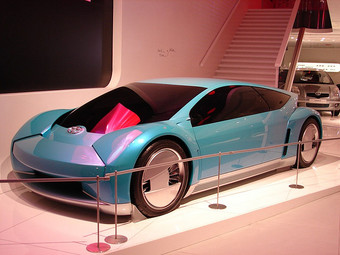
Prototype
A company develops a prototype in order to conduct further testing on a potential product.
Testing Process
While the laboratory technicians are working on the prototype, the marketing department is responsible for testing the new product with its intended consumers and developing the other elements of the marketing mix.
Concept Test
The testing process usually begins with the concept test. The product concept is a synthesis or a description of a product idea that reflects the core element of the proposed product. For example, a consumer focus group might be assembled and the interview session might begin with the question: “How about something that would do this?”
Consumer Testing
The second aspect of market development involves consumer testing of the product idea. This activity usually follows the construction of the prototype or limited production models. Various kinds of consumer preference can be conducted. The product itself can be exposed to consumer taste or use tests. Packaging, labeling, and other elements in the mix can be similarly studied.
9.6.8: Test Marketing
Test marketing is the final stage before commercialization, and is where all the elements of the marketing plan are tested.
Learning Objective
Discuss the requirements that must be satisfied to conduct successful test marketing of new products and distinguish test marketing from initial product testing
Key Points
- Initial product testing and test marketing are very different. The former involves providing consumers with the test product, and giving them an incentive to participate. The latter involves all the elements of the marketing plan, in a real-world setting meant to simulate the broader market.
- There are risks in test marketing, such as high initial marketing costs, the potential to lose customer goodwill before the official launch, and giving competitors the opportunity to quickly copy the product.
- Variables in the test marketing process include the selection and number of test cities, as well as the ideal sample size to use.
Key Term
- test marketing
-
The stage where all the variables in the marketing plan, as well as the product characteristics, are tested in a real-world setting.
Test Marketing
This is the final step before commercialization. The objective of the this marketing phase is to test all the variables in the marketing plan, including different elements and characteristics of the product. This stage represents the launching of the total marketing program, albeit on a limited basis.
Three questions can be answered through test marketing:
- Is the overall workability of the marketing plan realized as planned?
- Do alternative allocations of the budget need to be evaluated?
- Can we determine whether users are being inspired to switch from their previous brands to the new one, and whether repeat purchases are taking place?
In the end, the test market should include an estimate of sales, market share, and financial performance over the life of the product.
Initial product testing versus test marketing
Initial product testing and test marketing are not the same. Product testing is totally initiated by the producer: he or she selects the sample of people, provides the consumer with the test product, and offers the consumer some sort of incentive to participate.
Test marketing, on the other hand, is distinguished by the fact that the test cities represent the national market. The consumer must make the decision herself, must pay his or her own money, and the test product must compete with the existing products in the actual marketing environment. For these and other reasons, a market test is meant to serve as an accurate simulation of the national market and serves as a method for reducing risk. It should enhance the new product’s probability of success and allow for final adjustment in the marketing mix before the product is introduced on a large scale.
Risks
Test marketing is not without inherent risks. First, there are substantial costs in buying the necessary productive capacity needed to manufacture the product or locating manufacturers willing to make limited runs. There are also promotional costs, particularly advertising and personal selling . Although not always easy to identify, there are indirect costs as well. For example, the money used to test market could be used for other activities. The risk of losing consumer goodwill through the testing of an inferior product is also very real. Finally, engaging in a test-market might allow competitors to become aware of the new product and quickly copy it.
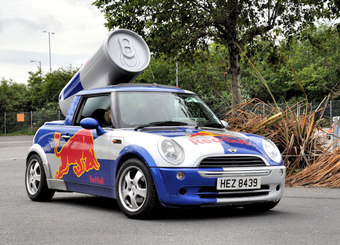
Test Marketing
Aggressive promotion in a limited geographical area is often a key element of the test marketing phase.
Because of the special expertise needed to conduct test markets and the associated expenses, most manufacturers employ independent marketing research agencies with highly-trained project directors, statisticians, psychologists, and field supervisors. Such a firm would assist the product manager in making the remaining test market decisions.
Variables
- Selection of test market cities: these cities should reflect the norms for the new product in such areas as advertising, competition, distribution system, and product usage.
- Number of test cities: should be based on the number of variations considered (i.e. vary price, package, or promotion), representativeness, and cost.
- Sample size determination: the number of stores used should be adequate to represent the total market.
Even after all the test results are in, adjustments in the product are still made. Additional testing may be required, or the product may be deleted if it does not perform well during this stage, or if it becomes apparent that the product is not likely to become a commercial success.
9.6.9: Commercialization
Commercialization the process of launching a new product; it may involve heavy promotion and filling the distribution networks with the product.
Learning Objective
Describe the three steps that must be implemented during the commercialization of new products
Key Points
- The timing of the launch should coincide with a good economic situation to maximize sales. Cannibalization of existing products should be avoided, and the product should only be launched when no further improvements are foreseeable.
- Companies must decide which location(s) to launch, depending on their target markets, capabilities, and marketing strategy.
- By targeting the primary consumer group (which includes innovators, early adopters, and opinion leaders), the company can ensure adoption by other buyers in the market place during the product growth period.
Key Term
- commercialization
-
The process of introducing a new product into the market.
At last the product is ready to go. It has survived the development process and it is now on the way to commercial success (if all goes well, that is!). ‘Commercialization’ is the process or cycle of introducing a new product or production method into the market. In this stage, the product is launched, advertisements and promotional activity begins and increases heavily, and the distribution pipeline is filled with the product. The actual launch of a new product is the final stage of new product development, and the one where the most money will have to be spent for advertising, sales promotion, and other marketing efforts.
The commercialization process
Commercialization of a product will only take place, if the following three issues are satisfied:
- Timing of launch: When facing the danger of cannibalizing the sales of the company’s other products, if the product can be improved further, or if the economy is down, the launch should be delayed.
- Launch location: It can be in a single location, one or several regions, a national or the international market. This decision will be strongly influenced by the company’s resources, in terms of capital, managerial confidence and operational capacities. Smaller companies usually launch in attractive cities or regions, while larger companies enter a national market at once. Global roll outs are generally only undertaken by multinational conglomerates, since they have the necessary size and make use of international distribution systems (e.g., Unilever, Procter & Gamble). Other multinationals use the “lead-country” strategy: introducing the new product in one country/region at a time.
- Target consumers: The primary target consumer group will have been identified earlier by research and test marketing. This primary consumer group should consist of innovators, early adopters, heavy users and/or opinion leaders. This will ensure adoption by other buyers in the market place during the product growth period.
The company has to decide on an action plan for introducing the product by implementing the above decisions. It has to develop a viable marketing-mix and create a respective marketing budget. When a plan is in place for each of these three issues, then the commercialization process may begin .
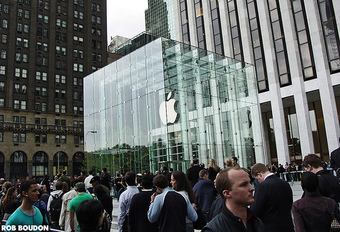
Launching a New Product
Whenever Apple launches a new product, there are crowds outside waiting to get their hands on the new product.
9.6.10: Success and Failure: Strategies to Improve Success
Marketers must learn from their own previous failures, and others’ failures, to ensure that they are successful for the next product launch.
Learning Objective
Describe how market structure and business model, culture and communication, political and regulatory, and product/service factors impact a company’s market success and failure
Key Points
- Four areas that marketers must pay attention to in order to maximize the chances of success are: (a) market structure and business model; (b) cultural and communication; (c) politics and regulation; and (d) product/service failure.
- Companies must align their business model to the structure of the market that the product is entering. No business model will work in all situations, and so it must be altered appropriately.
- Any product will run up against certain cultural factors. By understanding these, and avoiding problems (or even making use of such factors), companies can increase their chances of success.
- Companies must be aware of all legal regulations as well as potential political issues that may arise from the release of their product, and act accordingly to negate such issues.
Key Term
- cultural factors
-
Differences in cultures (be they national or corporate cultures) that managers must pay attention to in order to ensure success.
Example
- As we saw in the case study, Wal-Mart came up against all these factors when attempting to launch in Germany. With a finer appreciation of these potential issues, and a plan to counteract them, it would have had more success in the country.
Success and Failure
A product fails when it does not meet the objectives that were established before its release. The following case study describes Wal-Mart’s failure to enter the German market, and highlights many of the problems faced by marketers in making a successful product. By learning from the failures of others (and their own prior failures), marketers may learn how to succeed in future. For a summary of the reasons why products fail as applied to the Wal-Mart case.
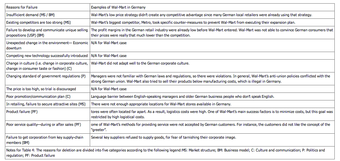
Wal-Mart’s Failure in Germany
Marketers face many challenges when making and introducing a successful product.
Wal-Mart case study
Wal-Mart is the world’s biggest food retailer. In some nations, it is a great success. However, it has failed in some countries (e.g. Germany, South Korea). Here, we will describe Wal-Mart’s failure in Germany, and use its experiences there to illustrate some key principles relating to product failure and deletion.
There is fierce competition in the German grocery industry, and thus, low profitability in the food retail sector; profit margins range from 0.5-1%. The main feature of Wal-Mart’s business model is to continuously cut costs and so offer lower prices than its competitors. Wal-Mart also continuously pressures its suppliers to cut costs.
In 1997-1998, Wal-Mart acquired over 95 stores from existing German supermarket chains, making it the fourth biggest supermarket operator in Germany. The objective was to expand to 500 stores. However, Wal-Mart never grew from the original 95 stores. By 2007, it was bought out by one of Germany’s largest retail groups. Ultimately, Wal-Mart left the German market with a loss of one billion dollars before tax.
There are four key issues related to Wal-Mart’s failure in Germany: (a) market structure and business model; (b) cultural and communication; (c) politics and regulation; and (d) product/service failure.
Market structure and business model
A retailer that wants to follow Wal-Mart’s strategy of low prices needs to expand rapidly. In Germany, there were not enough appropriate locations to support such expansion. Wal-Mart did not build their own stores, but took over existing supermarkets that had a completely different business model – they were very small and had a limited range of goods. They were also located far apart, which resulted in high logistical costs.
With their strategy of “everyday low prices,” Wal-Mart is very successful in the United States and elsewhere. However, due to the extreme competition, Germans are accustomed to the low prices that are offered by numerous discount supermarket chains. For this reason, Wal-Mart’s low price strategy did not create sufficient competitive advantage.
Culture
and communication
When products are introduced, it is important to consider cultural factors. Wal-Mart decided to operate its German locations from the UK. Thus, its “corporate language” was English. However, many of the older German Wal-Mart managers did not speak English. Some managers did not stay on after the Wal-Mart acquisition. Key business connections were lost, which resulted in the loss of major suppliers. It would have been far better to retain and communicate effectively with the German managers who had know-how about the local market.
Politics and regulation
Wal-Mart’s managers violated German laws repeatedly, simply because they were unfamiliar to them. For example, Wal-Mart always stays union-free, but Germany has a history of strong, politically powerful unions. Ver.di, one of Germany’s biggest unions, sued the company for failing to publish key financial statements in 1999 and 2000. A fine, as well as much negative press, harmed Wal-Mart’s reputation.
After its expansion strategy failed, Wal-Mart began a price war to drive small competitors out of business. One part of the price war was to introduce a private label called “Smart Brand” and sell most of these products below manufacturing costs. The reaction of many competitors was also to decrease their prices, which led to a profit setback for the entire industry. Finally, the Federal Cartel Office interceded and stopped the price war.
Product/service failure
Good customer service, combined with low prices, could have been a new market niche in Germany. One part of Wal-Mart’s customer service program was to ensure someone was always there to help. However, customer reaction was negative, because customers who normally do their grocery shopping in discount supermarket chains are used to self-service. They found this annoying, and it did not create a reputation for providing good customer service.
Conclusion
Wal-Mart tried to apply its U.S. success formula in an unmodified manner to the German market. As a result, they didn’t have sufficient knowledge about the market structure and key cultural / political issues. In addition, structural factors prevented Wal-Mart from fully implementing its successful business model. The final outcome was that it had to abandon its offerings in Germany. Had Wal-Mart paid careful attention to these issues prior to entering the German market, it could have had a very different outcome.
9.7: Differentiating Factors in Product Design
9.7.1: Quality
Consumers place a value on quality; therefore high quality products may be able to win share and/or command a price premium.
Learning Objective
Identify the attribute of quality at the design stage as a differentiating factor
Key Points
- Quality is considered a non-functional requirement in product design, affecting the execution and evolution of a product.
- The five aspects of quality in a business context include producing, checking, controlling, managing, and assuring quality in products and services.
- Manufacturers often view quality as a driver for productivity, increased revenues, and technological advances.
Key Terms
- extensibility
-
A quality of design that takes possible future advances into consideration and attempts to accommodate them.
- ISO
-
The ISO is the International Organization for Standardization.
- conformance
-
The act of conforming; conformity.
Quality
Quality in business, engineering, and manufacturing has a pragmatic interpretation as the non-inferiority or superiority of something; it is also defined as fitness for purpose. Product quality can vary depending on perception and is considered somewhat subjective since it may be understood differently by different people. When it comes to quality in product design, manufacturers might measure how well products conform to certain requirements or the level of accuracy in products and services following production. Consumers may focus on product features and how well the product compares to competing brands in the marketplace. Support personnel may measure quality in the degree that a product is reliable, maintainable, or sustainable.
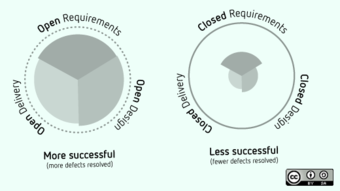
Improving Product Quality
Improving product quality in businesses can lead to better productivity and more innovation.
Quality is considered a non-functional requirement in engineering, affecting the execution and evolution of a product. Product qualities can be divided into two main categories:
- Execution qualities, such as security and usability.
- Evolution qualities, such as testability, maintainability, extensibility, portability, and scalability.
Product Quality in Business
During the 1960s, the U.S. military, aerospace, and nuclear industries developed the original versions of the Quality Management System Standards (eventually merged to ISO 9001). These standards were established to produce better products on a consistent basis, while focusing on production, conformance, and quality control mechanisms. Within areas such as product design and manufacturing, five main aspects of quality fall under this scheme. They include:
- Producing – providing a product or service.
- Checking – confirming that a product or service has been produced correctly.
- Quality Control – controlling a process to ensure that the outcomes are predictable.
- Quality Management – directing an organization so that it improves its performance through analysis and innovation.
- Quality Assurance – obtaining confirmation (usually from the purchaser or a third-party) that a product or service will be satisfactory.
Managing quality is fundamental to any activity, particularly in the design and manufacturing of consumer and industrial goods. For manufacturers of products, it is commonly stated that “quality drives productivity.” Better productivity is viewed in direct correlation to increased revenues, employee opportunities, and technological advances. Thus, businesses must have a clear understanding of all aspects of product quality, measure product performance, and adapt their market strategy for longevity and growth.
9.7.2: Design and Feature Set
Premium features and design may help differentiate a product to earn it share or a price premium in the marketplace.
Learning Objective
Outline the concept of design and feature sets as differentiating factors in product design
Key Points
- During product design, companies must consider factors such as cost, producibility, quality, performance, reliability, serviceability, and user features.
- Companies must be cognizant of feature creep, which is the ongoing expansion or addition of new features in a product.
- Product design teams can control feature creep by setting strict limits for allowable features or limiting features in some product versions.
- Once products reach the stage of maximum functionality, manufacturers face the choice of adding extraneous functions, sometimes at the cost of efficiency.
Key Terms
- feature creep
-
The tendency of a design project or product cycle to accumulate more and more features or details, rather than to be completed and released at a more basic level.
- serviceability
-
The property of being serviceable, of being useful for some function.
Design and Feature Set
In systems engineering, a requirement (often referred to as a functional requirement) can be a description of what a system must do. Another type of requirement specifies something about the system itself, and how well it performs its functions. Such requirements are often called non-functional requirements, performance requirements. or quality of service requirements. Examples of such requirements include usability, availability, reliability, supportability, testability, and maintainability. These requirements define the characteristics or features of the desired product during the design process .
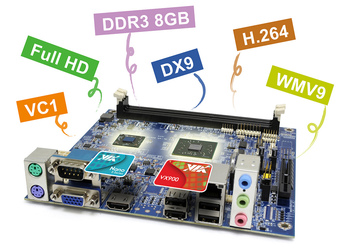
Product Features
Features must meet usability and reliability requirements before being built into products and systems.
Product Design Process
Product design involves developing a device, assembly, or system into an item for sale using a production manufacturing process. During product design, engineers and designers must consider factors such as cost, producibility, quality, performance, reliability, serviceability, and user features. A product must go through the design and development of its mechanical, electronics, and software components before transitioning to manufacturing for mass production.
For example, the development of digital cameras would include defining the feature set; designing the optics, as well as the mechanical and ergonomic aspects of the packaging; developing the electronics that control the various components; and developing the software that allows users to view and manipulate photos, store them to memory, and download to them to a computer.
Dangers Of Feature Creep
Customer demand for particular features or functionality can result in products tailored to very specific, niche markets. However, manufacturers must be cognizant of feature creep, which is the ongoing expansion or addition of new features in a product. Although providing consumers more useful or desirable products and increasing sales are priorities for most businesses, extra features going beyond product function can result in over-complication.
Once products reach the stage of maximum functionality, manufacturers face the choice of adding extraneous functions, sometimes at the cost of efficiency. On the other hand, the manufacturer must deal with ignoring older versions at the cost of being perceived by the market as stagnant or dated. Nevertheless, introducing a bloated feature set can move the product or system beyond its initial goals, increasing production costs and schedule overruns. Introducing too many requirements into a feature set has often been blamed for endangering and even killing products and projects.
Another major cause of feature creep might be a compromise from a committee which decides to implement multiple, different viewpoints in the same product. As more features are added to support each viewpoint, it might be necessary to have cross-conversion features between the multiple viewpoints, further complicating the total features.
Feature Control In Product Design
To control the number of product features during the design phase, manufacturers set strict limits for allowable features and multiple variations. Excess features are removed or delayed until the later delivery phases of the project. Quality control is also maintained through multiple variations of products, where features are kept limited in some versions. Because the ever-growing, ever-expanding addition of new features might exceed available resources, a minimal “basic” version of a product can be maintained separately to ensure operation in smaller operating environments.
Other companies might use the “80/20 Rule”, where more basic product variations might support the needs of about “80%” of the users. Thus, the bulk of end-users are not subjected to the complexity (or extra expense) of features requested by the remaining 20% of users. These extra features are still available, but may be available in only select versions of the products.
9.7.3: Support and Help
Excellent customer service can help differentiate a product or brand and may lead to increased brand loyalty over time.
Learning Objective
Examine the role of support and help programs as a differentiating factor in product design
Key Points
- Today, most major telecommunications, IT and electronic companies run virtual support and help desks to provide user assistance around the world.
- Virtual product support allows organizations to optimize their overall IT support process and gain competitive advantages when it comes to delivering quick and efficient technical support.
- Companies, especially larger organizations, often offer internal technical support and help desk services to their staff for computer-related problems.
- In addition to virtual help desks, product support and help services are delivered via email, toll-free numbers, or at physical locations.
Key Term
- extranet
-
A private computer network that uses Internet protocols and can be accessed by authorized individuals via the Internet.
Support and Help
Rapid globalization and expansion of technology are quickly making geography irrelevant; eliminating time constraints for customer support and help functions in organizations. Moreover, as more people telecommute from home and work from remote locations, internal information technology (IT) administrators must spend more time troubleshooting and fixing employees’ problems.
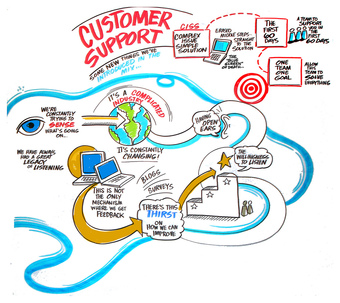
Customer Support
In today’s interconnected world, product support and help services are delivered through multiple channels.
This increased demand for technical services requires IT support organizations to be more agile in diagnosing and resolving product issues. Today, most major telecommunications, IT and electronic companies run virtual support and help desks to provide user assistance around the world. As a result, these organizations are able to optimize their overall IT support process and gain competitive advantages when it comes to delivering quick and efficient technical support.
The Role of Product Support and Help Services
Users of mobile phones, televisions, computers, software products, and other electronic or mechanical goods will occasionally need product support services. This service is usually offered in the form of a help desk that acts as an information and assistance resource. Product support professionals attempt to help users solve specific problems with a product—rather than providing training, customization, or other support services.
Most companies offer either free customer support or charge for premium customer support and help services. Companies, especially larger organizations, offer internal technical support and help desk services to their staff for computer-related problems.
Types of Product Support and Help Services
The Internet serves as a primary source for freely available product support. Virtual help desks, which allow organizations to virtually deploy IT technicians on demand to support users can efficiently manage and allocate organizational resources. Product support personnel can access any computer to provide support despite the end users’ or technicians’ location.
Some companies develop extranet sites, or customer websites that allow users to log calls and report incidents. Virtual help desks access these systems through support sessions where they can diagnose and fix computer issues quickly. This eliminates in-person customer service calls and ineffective phone-only tech support sessions, making the help desk more efficient.
However, many organizations still offer support services via email and toll-free numbers. Some companies also offer live support at physical stores and locations. Nevertheless, the Internet has allowed for a new form of product support to develop. Some online communities, which are moderated by product users, have emerged to give support where manufacturer support is lacking. These experienced users may provide advice and assistance with problems, or offer work-arounds to fellow users unable to find solutions on their own or through the vendor.
9.7.4: Deletion
Product deletion, either through product replacement or product elimination, results when products fail to meet company expectations.
Learning Objective
Illustrate the reasons for and the impact of product deletion
Key Points
- Companies are increasingly under pressure to evaluate their existing product line and make continuous decisions about adding new products or deleting existing ones.
- In addition to weak sales and profit, brands delete products that fail to align with marketing strategies or that demonstrate an unfavorable market outlook.
- Product failure rates vary by industry, but it is estimated that failure rates for new packaged goods range anywhere from 75% to 90%.
Key Term
- revenue stream
-
A revenue stream is a method that a company, organization, or individual uses to collect money—often automated—from users of their product or service. In essence, it is a method of earning money and a way to protect it.
Example
- Coca-Cola Vanilla is the limited relaunch of the formerly produced Vanilla Coke soft drink from the early 2000s to compete with Pepsi Vanilla. Doubt was cast over the future of Vanilla Coke and its splinter beverages when the company announced the 2004 sales figures: 35 million unit cases in North America compared to 90 million in 2002; Vanilla Diet Coke dropped from 23 million unit cases in its inaugural year (2003) to 13 in 2004. On November 3, 2005, The Coca-Cola Company announced that Vanilla Coke and its diet counterpart would be discontinued in the United Kingdom and Ireland by early 2006. A day later, it was announced that it would be phased out in North America by the end of 2005.
Deletion
The twenty-first century marketplace is dynamic, fast-changing, and increasingly fickle. More and more businesses realize that no product lasts forever, and that sales levels can fluctuate dramatically over time. As a result, companies are under pressure to evaluate their existing product line and to make continuous decisions about adding new products or deleting existing ones. Brands must task their engineering and design teams to produce successful products that generate a consistent stream of sales for both short-term profit and long-term survival. An organization must establish a series of successful products, if that organization wants to maintain a consistent stream of sales or else grow sales over time. One reason for this pattern is the product life cycle. No product lasts forever, and sales levels can fluctuate dramatically over time.
Factors in Product Deletion
Deletion is the process of removing products that perform below market expectations or fail to meet company objectives. Deletion results in either product replacement or product elimination. Product deletion requires the company to evaluate its entire product mix and pinpoint where organizational resources can be allocated elsewhere to generate consistent revenue streams.
In addition to weak sales and profit, brands delete products that fail to align with marketing strategies, or that demonstrate an unfavorable market outlook. Market trends and consumer tastes often dictate whether products perform well in the long-term or taper off as a passing fad. However, factors including a company’s business model, culture (or local tastes), government politics and/or regulations, and product malfunction can all contribute to the removal of a product.
Failure rates of products vary by industry. Despite significant investment in product development and market research, it is estimated that failure rates for new packaged goods range anywhere from 75% to rates as high as 90% (source: catalinamarketing.com). When considering “innovative” new products, Harvard Professor John T. Gourville estimates that approximately half of all such products fail.
Business Impact of Product Deletion
Once a company eliminates a product from its offering, the brand must decide whether its goal is to maintain or increase sales. To maintain revenues, the company must continue investing in its remaining products and ensure they are competitively positioned in the marketplace. However, if the company seeks to increase sales in the near future, then it must introduce a new group of successful products to generate additional revenue.
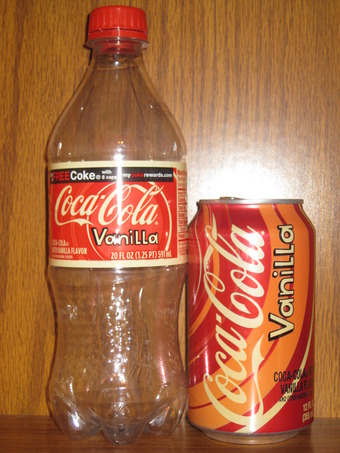
Coca-Cola Vanilla
Coca-Cola Vanilla was the limited relaunch of Vanilla Coke from the early 2000s to compete with Pepsi Vanilla. It was phased out in North America by the end of 2005 due to low sales.
9.7.5: Organizational Requirements for Product Development and Management
Product development combined with product marketing make up the product management function within an organization.
Learning Objective
Construct the relationship between product development and product management
Key Points
- Product management spans many activities, from strategic to tactical, and can be shared by other roles, such as product engineering.
- Many interpretations exist for product management roles and functions and vary depending on company size, history and industry.
- Product management often serves an interdisciplinary role, bridging gaps within the company between engineering-oriented teams and commercially oriented teams.
- To facilitate the launch and marketing of new products, product management teams may perform tasks, including research and competitive intelligence, and sales training.
Key Term
- lifecycle
-
the stages through which a product or its category bypass, from its introduction to the marketing, growth, maturity to its decline or reduction in demand in the market.
Organizational Requirements for Product Development and Management
Product management is an organizational lifecycle function within a company dealing with the planning, forecasting, or marketing of a product or products at all stages of the product lifecycle. Product development – the process of bringing new products to the marketplace – combined with product marketing, make up the product management function that oversees the launch of a company’s new products.

Product Launch
Some organizations set up product management teams so that they intersect between marketing and engineering activities.
Product management spans many activities, from strategic to tactical, and varies based on the organizational structure of the company. Product management can be a function separate on its own, or fall under marketing or engineering.
Functional Requirements of Product Management
Depending on the company size and history, product management has a variety of functions and roles, and can be shared across different departments, such as product development or engineering. A product manager investigates, selects, and develops one or more tangible products for an organization. However, product management also deals with intangible products, such as music, information, and services. Many interpretations exist for product management roles and functions and vary depending on company size, history, and industry.
The Intersection between Product Management, Product Development and Marketing
Frequently there is Profit and Loss (P&L) responsibility as a key metric for evaluating product management performance. In some companies, the product management function is the hub of many other business activities around the development and launch of a product. In other organizations, product management is one of several things that need to occur to successfully launch, monitor, and manage a product. Product management often serves an interdisciplinary role, bridging gaps within the company between different sets of expertise.
This intersection most commonly happens between engineering-oriented teams and commercially-oriented teams. Often, product management professionals serve as the middlemen between product development and engineering and marketing and sales teams. They often translate business objectives set for a product by marketing or sales into engineering requirements for product development. Conversely, the product management team may work to explain the finished product’s capabilities and limitations to marketing and sales professionals. This constant exchange between technical and business teams ensures that product benefits and features are accurately communicated to target audiences.
To facilitate this communication process, product management teams will perform activities including customer research, competitive intelligence, industry analysis, and competitive analysis. Likewise, product management works closely with marketing distributing messages, training sales people, developing market strategies, and communicating messages through advertising and public relations channels.
9.8: The Spread of New Products
9.8.1: The Diffusion of Innovation
The diffusion of innovation theory seeks to explain how, why, and at what rate new ideas and technology spread through cultures.
Learning Objective
List the four main elements that influence the spread of new ideas and technologies
Key Points
- Everett Rogers, a professor of rural sociology, popularized the theory in his 1962 book Diffusion of Innovations.
- Four main elements that influence the spread of a new idea are the innovation, communication channels, time, and the social system.
- Diffusion of innovations manifests itself in different ways in various cultures and fields and is highly subjective to the type of adopters and innovation decision process.
- Marketers are particularly interested in the diffusion process as it determines the success and failure of any new product introduced in the market.
Key Term
- innovation
-
As used here, innovation describes an idea or product that is new to the company in question.
The Diffusion of Innovation
The diffusion of innovation is a theory that seeks to explain how, why, and at what rate new ideas and technology spread through cultures. The origins of the diffusion of innovation theory are varied and span multiple disciplines. Everett Rogers, a professor of rural sociology, popularized the theory in his 1962 book Diffusion of Innovations. He said diffusion is the process by which an innovation is communicated through certain channels over time among the members of a social system. Rogers synthesized research from over 508 diffusion studies and produced a theory for the adoption of innovations among individuals and organizations. Rogers (1962) espoused the theory that there are four main elements that influence the spread of a new idea:
- The innovation – According to Rogers, an innovation is “an idea, practice, or object that is perceived as new by an individual or other unit of adoption.”
- Communication channels – These are “the means by which messages get from one individual to another.”
- Time – Rogers wrote that “the innovation-decision period is the length of time required to pass through the innovation-decision process. The rate of adoption is the relative speed with which an innovation is adopted by members of a social system.”
- Social system – According to Rogers, a social system is “a set of interrelated units that are engaged in joint problem solving to accomplish a common goal.”
Diffusion of innovations manifest themselves in different ways in various cultures and fields and is highly subjective to the type of adopters and innovation decision process. Marketers are particularly interested in the diffusion process as it determines the success and failure of any new product introduced in the market. They usually look forward to procuring the largest amount of adoption within the shortest period of time. Thus, it is quite important for a marketer to understand the diffusion process so as to ensure proper management of the spread of the new product or service.

Market Share
With successive groups of consumers adopting the new technology (shown in blue), its market share (yellow) will eventually reach the saturation level.
9.8.2: The Rate of Adoption
The rate of adoption is defined as the relative speed with which members of a social system adopt an innovation.
Learning Objective
Discuss the factors leading to adoption of an innovation, and the strategies for making innovation sustainable
Key Points
- Critical mass is the point within the adoption curve that enough individuals have adopted an innovation such that that the continued adoption of the innovation is self-sustaining.
- The adoption process is an individual phenomenon the describes the series of stages an individual undergoes from first hearing about a product to finally adopting it.
- The diffusion process essentially encompasses the adoption process of several individuals over time.
Key Terms
- intrinsic
-
Innate, inherent, inseparable from the thing itself, essential.
- critical mass
-
A quantity or amount required to trigger a phenomenon.
The Rate Of Adoption
The rate of adoption is defined as the relative speed with which members of a social system adopt an innovation. It is usually measured by the length of time required for a certain percentage of the members of a social system to adopt an innovation. Within the rate of adoption there is a point at which an innovation reaches critical mass. Critical mass is the time in the adoption curve when enough individuals have adopted an innovation so that the continued adoption of the innovation is self-sustaining. Everett Rogers outlines several strategies to help an innovation reach this stage:
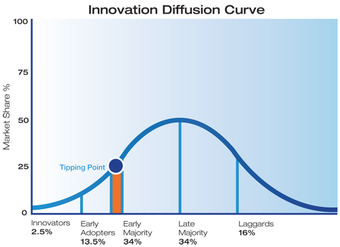
Diffusion of Innovation
This graph shows the innovation curve and the tipping point, or critical mass.
- Have an innovation adopted by a highly respected individual within a social network, creating an instinctive desire for a specific innovation.
- Inject an innovation into a group of individuals who would readily use an innovation.
- Provide positive reactions and benefits for early adopters of an innovation.
The adoption process is an individual phenomenon describing the series of stages an individual undergoes from first hearing about a product to finally adopting it. On the other hand, the diffusion process signifies a group of phenomena, which suggests how an innovation spreads among consumers. Overall, the diffusion process essentially encompasses the adoption process of several individuals over time.
Five Adoption Factors
Rogers defines several intrinsic characteristics of innovations that influence an individual’s decision to adopt or reject an innovation:
- Relative Advantage: How improved an innovation is over the previous generation.
- Compatibility: The level of compatibility that an innovation has to be assimilated into an individual’s life.
- Complexity or Simplicity: If the innovation is perceived as complicated or difficult to use, an individual is unlikely to adopt it.
- Trialability: How easily an innovation may be experimented. If a user is able to test an innovation, the individual will be more likely to adopt it.
- Observability: The extent that an innovation is visible to others. An innovation that is more visible will drive communication among the individual’s peers and personal networks, and will in turn, create more positive or negative reactions.
9.8.3: Stages of Adopters
The stages of adopters for the diffusion of innovation include knowledge, persuasion, decision, implementation, and confirmation.
Learning Objective
Describe the five stages detailed in Everett Rogers’ adoption process
Key Points
- Diffusion occurs through a series of communication channels over a period of time among the members of a similar social system.
- An individual might reject an innovation at any time during or after the adoption process.
- Previous terminology for the stages of adopters included awareness, interest, evaluation, trial, and adoption.
Key Terms
- social system
-
The interaction of at least two personal systems or two persons acting in their own roles.
- diffusion
-
The act of diffusing or dispersing something, or the property of being diffused or dispersed; dispersion.
Stages of Adopters
Diffusion of an innovation occurs through a five–step process. This process is a type of decision-making. It occurs through a series of communication channels over a period of time among the members of a similar social system. Everett Rogers categorizes the five stages (steps) of adopters as:
- Awareness
- Interest
- Evaluation
- Trial
- Adoption
An individual might reject an innovation at any time during or after the adoption process. In later editions of The Diffusion of Innovations, Rogers changes the terminology of the five stages to: knowledge, persuasion, decision, implementation, and confirmation. However the descriptions of the categories have remained similar throughout the editions. The five stages of the adoption process are:
- Knowledge: In this stage the individual is first exposed to an innovation but lacks information about that innovation. During this stage of the process the individual has not been inspired to find more information about the new idea.
- Persuasion: In this stage, the individual is interested in the innovation and actively seeks information and details about it.
- Decision: In this stage, the individual takes the concepts of change (switching cost), weighs the advantages and disadvantages of using the innovation, and decides whether to adopt or reject the innovation. Due to the individualistic nature of this stage, Rogers notes that it is the most difficult stage to acquire empirical evidence.
- Implementation: In this stage, the individual employs the innovation to a varying degree depending on the situation. During this stage the individual determines the usefulness of the innovation and may search for further information about it.
- Confirmation: Although the name of this stage may be misleading, in this stage, the individual finalizes his or her decision to continue using the innovation and may end up using it to its fullest potential.
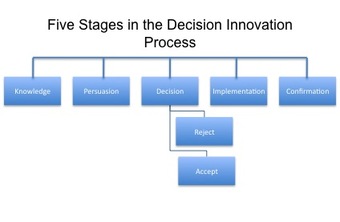
Stages of Diffusion
There are five stages of the diffusion of innovation.
9.8.4: Applying the Diffusion of Innovation Theory
In applying the diffusion of innovation theory, it is important to understand potential adopters and their decision-making process.
Learning Objective
Illustrate how the diffusion of innovation theory influences consumer adoption of products and services
Key Points
- Important factors in decision making include whether the decision is made freely and implemented voluntarily, and who makes the decision.
- Opinion leadership tends to be organized into a hierarchy within a society, with each level having the most influence over other members in the same level, and on those in the level below it.
- Public consequences refer to the impact of an innovation on those other than the actor, while private consequences refer to the impact on the actor itself.
- Direct costs of the diffusion of innovation are usually related to financial uncertainty and the economic state of the actor. Indirect costs may be social, such as social conflict caused by innovation.
Key Terms
- horizontal conflict
-
channel conflict between intermediaries at the same level within a channel
- hierarchy
-
Any group of objects ranked so that every one but the topmost is subordinate to a specified one above it.
- vertical conflict
-
psychological tension or anxiety between two alternatives that are not simply different, but where one is genuinely higher than the other
Applying the Diffusion Of Innovation Theory
In applying the diffusion of innovation theory, it is important to understand potential adopters and their decision-making process. Important factors in decision making include who makes the decision, and whether the decision is made freely and implemented voluntarily. Based on these considerations, three types of innovation decisions have been identified:
- Optional innovation decision: This is made by an individual who is in some way distinguished from others in a social system.
- Collective innovation decision: This is made collectively by all individuals of a social system.
- Authority innovation decision: This is made for the entire social system by a few individuals in positions of influence or power.
There are categories of adopters that serve as a classification of individuals within a social system on the basis of innovativeness. According to Everett Rogers , these categories include:

Categories of Adopters
Categories of innovation adopters include innovators, early adopters, early majority, late majority, and laggards.
- Innovators: Innovators are the first individuals to adopt an innovation. Innovators are willing to take risks, youngest in age, have the highest social class, have great financial liquidity, are very social, and have the closest contact to scientific sources and interaction with other innovators. Risk tolerance has them adopting technologies which may ultimately fail, though their financial resources help them absorb these failures.
- Early adopters: This is the second fastest category of individuals who adopt an innovation. These individuals have the highest degree of opinion leadership among the other adopter categories. Early adopters are typically younger in age, have a higher social status, have more financial liquidity, possess an advanced education, and are more socially forward than late adopters. They are more discrete in adoption choices than innovators, as they realize that judicious choice of adoption will help them maintain a central communication position.
- Early majority: Individuals in this category adopt an innovation after a varying degree of time. This time of adoption is significantly longer than with the innovators and early adopters. The early majority tends to be slower in the adoption process, has above average social status, has contact with early adopters, and seldom holds positions of opinion leadership in a system.
- Late majority: Individuals in this category will adopt an innovation after the average member of the society does. These individuals approach an innovation with a high degree of skepticism. The late majority typically has below average social status, has very little financial liquidity, shares contact with others in the late majority and the early majority, and has very little opinion leadership.
- Laggards: Individuals in this category are the last to adopt an innovation. Unlike some of the previous categories, individuals in this category show little to no opinion leadership. Laggards typically tend to be focused on “traditions”, are likely to have the lowest social status, have the lowest financial liquidity, be the oldest of all other adopters, and are in contact with only family and close friends.
Research done in the early 1950s at the University of Chicago attempted to assess the cost-effectiveness of broadcast advertising on the diffusion of new products and services. The findings were that opinion leadership tended to be organized into a hierarchy within a society, with each level having most influence over other members in the same level, and on those in the next level below it. The lowest levels were generally larger in numbers, and tended to coincide with various demographic attributes that might be targeted by mass advertising. However, the study found that direct word of mouth were far more influential than broadcast messages, which were only effective if they reinforced the direct influences. This led to the conclusion that advertising was best targeted, if possible, on those next in line to adopt, and not on those not yet reached by the chain of influence.
Consequences Of Adoption
There are both positive and negative outcomes when an individual or organization chooses to adopt a particular innovation. In her article, “Integrating Models of Diffusion of Innovations,” Barbara Wejnert details two categories for consequences: public and private. Public consequences refer to the impact of an innovation on those other than the actor, while private consequences refer to the impact on the actor itself. Public consequences are usually concerned with issues of societal well-being, while private consequences are usually concerned with the improvement of quality of life or the reform of social structures.
Benefits Versus Costs
The benefits of an innovation obviously refer to the positive consequences, while the costs refer to the negative. Direct costs are usually related to financial uncertainty and the economic state of the actor. Indirect costs may be social, such as social conflict caused by innovation.
